


|
We trust DT Swiss spokes for our custom high performance wheelbuilds. We chose the Aerolite and the Competition for their qualities, their compatibility and theyr modularity.
DT Aerolite
The Aerolite spokes might be replaced by Sapim Cx-ray spokes in case of unavailability or special requirements such as straight pull heads spokes.
DT Competition 2.0/1.8
Pillar PST TB Aero 1422
This is the lightest spoke ever. The PST TB Aero shares good mechanical properties: 260kg of tensile strength and the fatigue tests are of good omen.
|

This year, two super light bikes have been presented at the Eurobike. The first one at Spin booth, is the « world’s lightest bike ». We will not present it because this challenge is turning to real
madness and doesn’t really bring something interesting. As information, this bike only has 6 cogs, from 11 to 16, it has got downtube shifters. About the aesthetics, it could certainly have been
nicer. In short, we pass over the details… and the whole bike even though it only weights 3.3 kg.
The second bike really shows creativity and assembling effort. Basically, every light bikes are all black because of the carbon. This one follow the rule. The touch of metal are rare.
Sebastian Roth chose a Scott Addict for his project. Exoticand handmade components, hand tuned parts, most of the components are either unavailable on the market either very
pricey. Let’s see together what are the particularities of this 3610g machine.
Scott Addict SL
First of all, the frame is all sanded to remove any trace of coat and thus, have the lowest weight. Then, a very thin clear coat is used to protect the carbon from the scratches. It weights a mere
673,1g.
The fork is coming from the german manufacturer THM Carbones. With some modifications, it is only 221g.
Lightweight Challenge 700
The wheels are the all new Challenge 700 from Lightweight. With only 759,6g these wheels are the lightest ever built. They feature full carbon spokes for a higher stiffness, just
like all the Generation 3 Obermayer and Standard wheels. It makes them look a little like the Mavic CCU.
Only a couple of these wheels have been made until today. It is only a project, that’s why they are not in the 08′ catalog. On this bike, the lightest one have been chosen. The wheels were mostly
all around 760g and 790g. The Challenge 700 feature several details, which will be used for the later Obermayer wheels.


The seatpost and saddle combo
This component is incredible, technically speaking. The saddle and the seatpost are only one piece. Nothing really new but the particularity of this component is to be entirely monobloc . Usually,
saddle and seatpost combo are somewhat two pieces, originally separated, then bonded. Here the fibres are not interrupted, it brings an exceptionnal resistance and especially a fluid and superb
line. The weight of this combo is incredibly low: 104,9g!
It seems like, Charlie Mike, behind this, has serious knowledge to work the black fiber. Fantasy touch, a small cow on the saddle makes it look funny although it’s a very
specialized and light part!

Click to enlarge (129Kb)
« /upload/images/Sebastian-s-bike/saddle-5.jpg »>

Click to enlarge (127Kb)

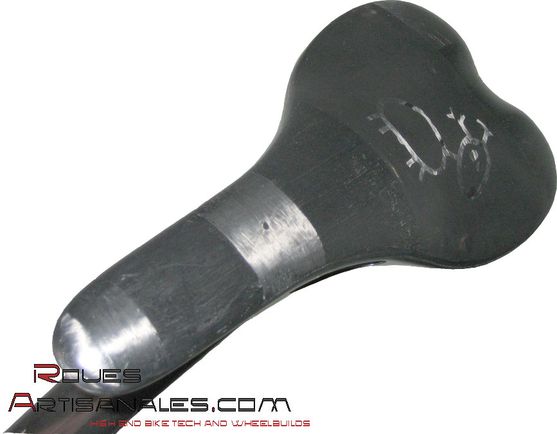 |
|
 |
 |
The Ergo hoods
The german BTP carbon fibre hoods reduce the weight of the shifters. With only 10g a set, this part add an extra exotic touch to the bike. We can’t complain about the grip or the fit onto the
Ergopower body. It seems like it is a real future best-seller for all techno-weenies.


The stem
If there were a component we could criticize on this bike, it is this one. Entirely made out of carbon, the torque have to be quite low to prevent the fibers from being crushed. The stem/handlebar
stiffness is correct but it will not be enough for a racer or a cyclo well padded. In this case, it will be smart to use an oversized alloy combo such as Deda Newton for example. About the weight,
the stem hit the scale with 60g and the bars are about the same weight as two gulps of energetic drink! (134,6g)
The transmission and the braking
You can notice that a bike correctly assembled and really rideable from these points. Here the shifters are Campagnolo Record. The chainring shifter is on the downtube while the rear derailleur one
is a standard Record on the handlebars. It is actually not a standard shifter, several parts have been lightened or removed.
The derailleurs are from Lightweight or Campagnolo Record. The rear one is less than 100g, this is the latest baby of Carbon-Sports, which is not really available yet, but it is already tuned…!
Normally you have to count about 120g for the derailleur, change the jockey wheels to save 10g, make it perspire a bit more with alloy bolts for an extra diet.
The front one is a Record. Well.. originally it was. There is not a lot of things left from Campagnolo on this component. The spring is titanium, some plastic inserts are removed, the entire body
in in carbon, etc… 32,2g for the whole component!
The KMC X10SL chain is very reliable and well tested. The Stronglight alloy cassette is not the best one for the
longevity. It will wear quicker than a traditionnal cassette but still, you can ride thousands kilometers with it!
The chainrings come from Fibre-Lyte in super light version. The stiffness is lower than the standard version but enough if the watts are not too high. About the length of life, we have to tell that
they are excellent. The only thing we have to worry about is to reduce the power while shifting. You can expect from 2000km to 5000km depending on the using mode and the cleanings!

Now, last but not least, the braking is incredibly smooth. The lowest strength on the lever activate the caliper. This is far from what the italian manufacturer Campagnolo proposes, on standard
with its housings. The Powercordz cables coupled with Nokon carbon housings work flawlessly. Ax-Lightness caliper springs come back to position perfectly. This is, we have to enlighten it, rarely
the case of the very light salon bikes…

It’s thursday, the first day of Eurobike. Zipp Speed Weaponry welcomes the journalists to their press-conference, where they will present the 2008 line-up. For us,
it turned out to be the first real highlight, since we didn’t know what expect and were quite surprised by some of the new stuff.
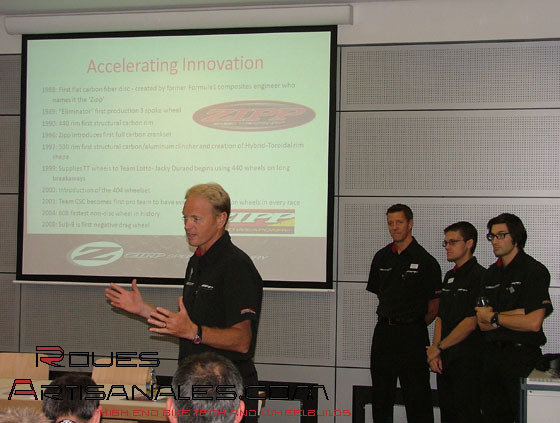
Zipp totally live up to their name. It’s obvious, this year’s main goal of most companies was weight-reduction. Lightweight and LEW introduced sub-800 and sub-900 gram wheelsets, the
frame-builders shave more and more weight off their rigs, too, and broke the 800 gram barrier and the first complete groupset below 2kg hit the market.
Not so Zipp – at least concerning their wheels. Yes, their wheels are light (Heck, actually, their disc is one of the lightest available!) and you will not be able to blame them,
when you’re training buddies leave you behind on the climbs, but still, their main objective was – and remains – to increase the aerodynamical properties of their hoops and their resistance
too.
They are well-known for the effective collaboration with Team CSC and excessive wind-tunnel testing. All Zipp wheels are designed to offer the perfect wind-cutting properties
under certain angles – the most likely ones of course, which are between 10 and 20°. (See a diagram further below)
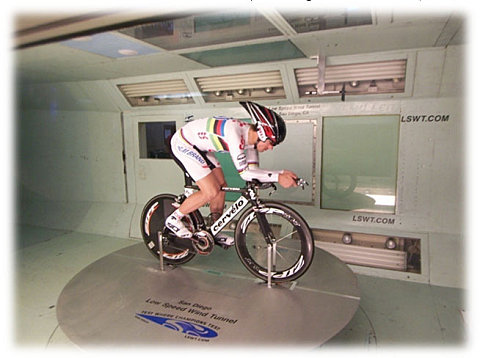
Now there’s just one question to be answered: Have Zipp worked on the weakness of their rims – the impact resistance? According to Andy Paskins, they did…. with
great success.
A new technology, called “Carbon Bridge” helps Zipp to create rims with 28% higher impact resistance
than any other rim ever made at this weight. It’s making the rims so strong, that Zipp actually removed fibre layers from the rim-bed to keep the weight on the same level as
previous models. Usually, rims rely on 2-dimensional layup technique, while the layers are beeing held together by a special resin. In most cases of rim failures, it’s not the fibres that fail,
but the resin that holds them together. What Zipp did, is adding some kevlar, but not in the same way many other companies do it, because it wouldn’t solve the actual
problem.
They “have added Kevlar thread in a co-axial helix stitch to bind the layers together in all 3 dimensional planes. The Kevlar is holding the carbon together and distributing the impact
force 3-dimensionally throughout the plies of carbon. Further, the Helix stitched carbon serves as capstone at the top of each outside diameter bridge, distributing the compressive forces
down to the rim.”
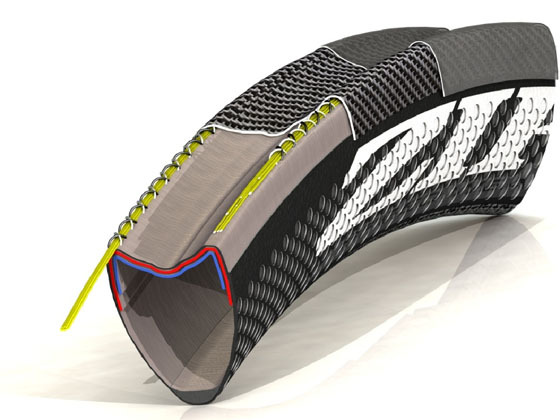
Zipp’s
climbing wheelset has received a complete overhaul for 2008. Deeper rims (32mm now), more aerodynamic rim shape, Carbon-bridge technology and savings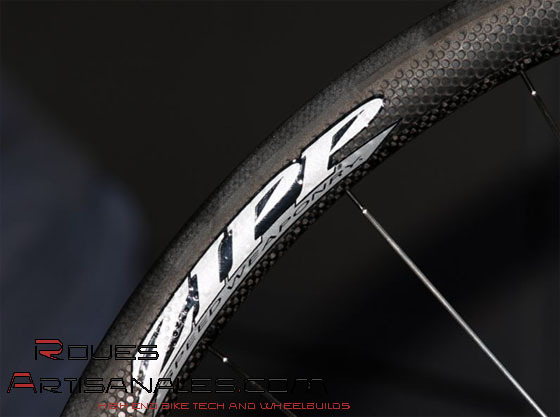
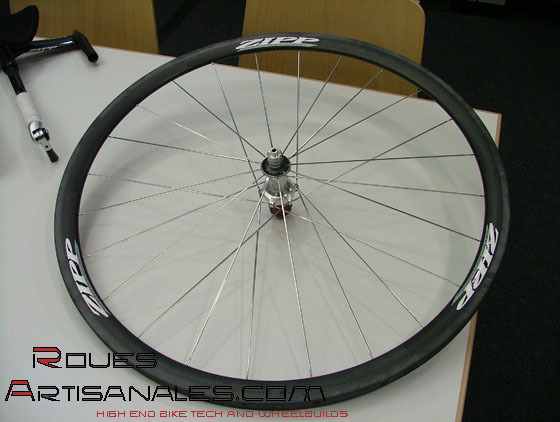
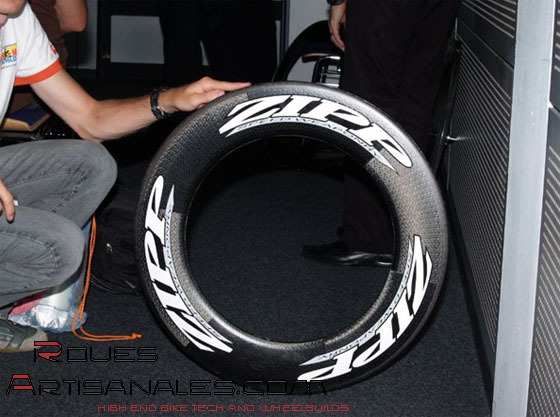
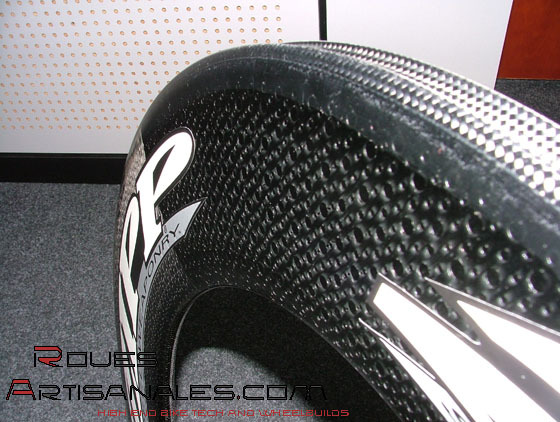
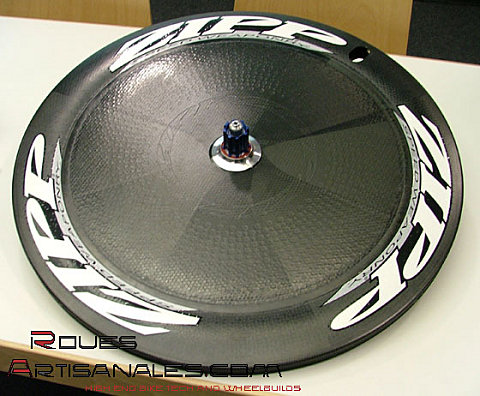
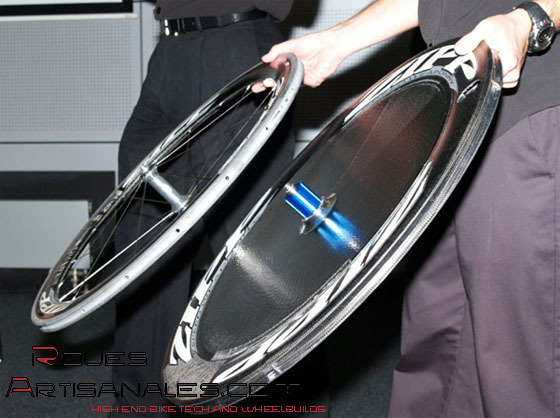
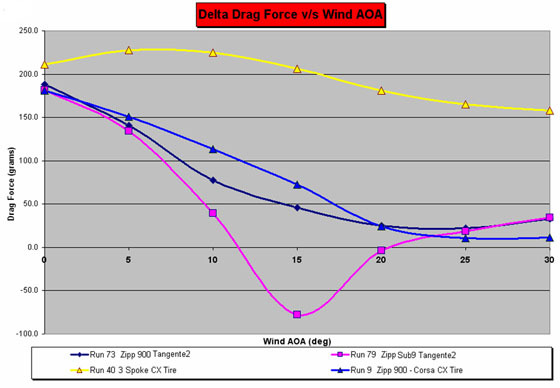
VumaQuad crankset
2 years after the Zipp 300 crankset hit the market and made some big weaves, its big brother, the VumaQuad has even higher aims. The
The featherweight carbonfibre crankarms come in a special 4 arm design with Zipp’s very own FEA designed US manufactured chainrings, available in 34/50 or 39/53.
The US made bearings has 17% higher fatigue life than traditional external BB bearings thanks to a super high-quality grease from Japan.
The crankset (incl. All the hardware, chainrings, bearings and BB cups) hits the scale at a mere 560 grams! Compare that to currently lightest availble cranks – the Clavicula – which is
only 10 grams lighter, when used with Stronglight’s CT² chainrings. Please consider, Zipp claim the VumaQuad is 33% stiffer than the next-lightest competitor.
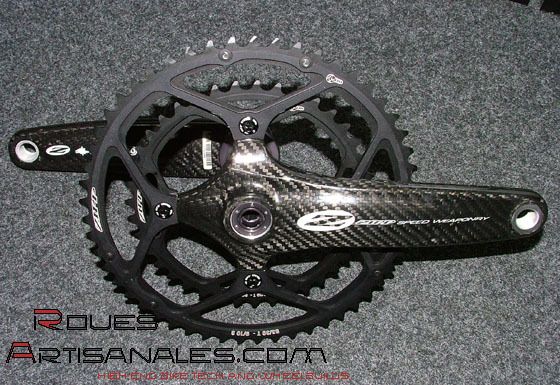
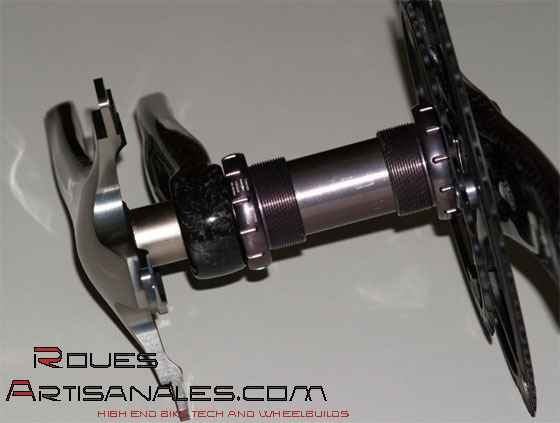

Speedplay
Speedplay unveiled an amazing pedal called the Zero Nanogram. It weights 62g thanks to a Ti axle, a carbon composite body. This is a race model, the availability is for December 08. We´ll test ride
it.
The other new models are not for racing, there use is rather about sport.
Shimano
Some more pictures from Shimano. The 7850 C50 clincher and tubular plus the C24.
Simplon
A beautiful frame.
Stronglight
Stronglight has a new crankset. Its particularity is that the large and small chainrings have hidden bolts. The axle is titanium,
Easton
Easton unveiled new components. First there is a crankset, second there is a new carbon low profile wheelset then we could see a couple of changes in the wheel range such as a clincher set
built with an alloy/carbon rim.
Giant
The latest T-Mobile bike that has been used during the Tour de France.
Colnago
The newest Extreme Power is really beautiful. We´ll present it in details later.
Mavic
Mavic presented a minor evolution of the Ksyrium ES: the ksyrium SL Premium is full black which is definitely classier. It is equipped with Ti skewers and the cost is 900 euros. The ES
disappears because it was an « anniversaire » edition, the SL replaces it: 800 euros.
Isaac

THM Carbones
A very special rear derailleur is in testing. It´s aero and features a box shape.
Schmolke
Some new finishes for the product: the 12K weave seem to be very famous these days. There is the new bars too but it was already unveiled some weeks ago.
FRM
FRM has designed a brand new carbon. It´s far stiffer than standard carbon. It´s a honey structure.
There is a new stem too.
DT Swiss
Several manufacturers have focused on clincher carbon wheels this year. DT Swiss is among them. A new rim made in their factory in switzerland. It weights around 300g. The complete wheelset is
1250g for 3000 euros including the Ti skewers ( price to be checked). The hubs are the 190 Ceramic.
Zipp
We have been at Zipp press conference. There are very interesting products:
– Zipp 255: the rim replaces the 250, it is the one we presented in yesterday´s article. It is 32mm deep, it is dimpled, it features a new
technology to increase the upper tube bed impact resistance of 32%. The weight is the same as the old 250. The dimples make it behave as a 50mm deep standard V shaped rim.
– Zipp 1080: the rim is 108mm deep!!! Perfect for time trial or triathlon.
– Zipp new crankset. We´re missing some infos but we will write a more extensive article about Zipp later.
– The new time trial wheel: it looks like a 808 rim bonded to a carbon structure. Zipp claims it has a negative drag! It´s something like it pushes you: you can earn 5 Watts at
350W. If you remember, we already shown this wheel about a year ago…
– Some new TT stuffs like bar extenders, shifters…
Cervelo
The RS:
Michelin
The Michelin Pro 3 is 200g, it is 27% more adhesive than the Pro 2 while cornering. It features a vectran puncture layer.
Shimano
Some pictures of Shimano wheels. Nothing new but close pictures are always interesting.

This year Rotor unveiled two new products.
The new S1 stem is CNC machined from a forged block of aluminium 7175.
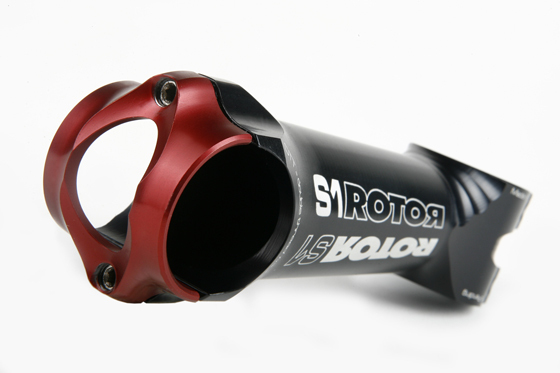
The treatments applied on this block bring high mechanical properties: fatigue resistance and stiffness while keeping a minimal weight. Here the treatment is a T6, synonym of a quench: the
hot aluminium block is cooled in a cold liquid to reduce cristallinity and thereby increase toughness but the fragility too. So the block is warmed up again then cooled down at ambient temperature
to reduce the too high effects of the quench. It makes it less fragile and provide excellent fatigue resistance..

This stem is special for its system of double threaded bolts. In short, you tight the bars or the fork steering tube thanks to the thread difference. Thus, when you turn the bolt, a thread
moves more than the other one and this allows the tight. Very clever!
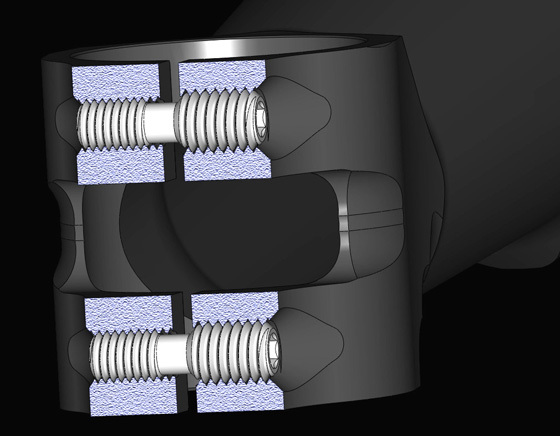
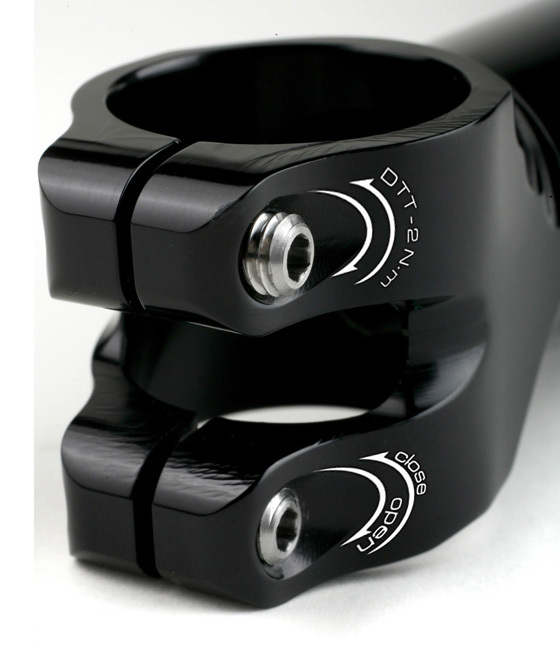
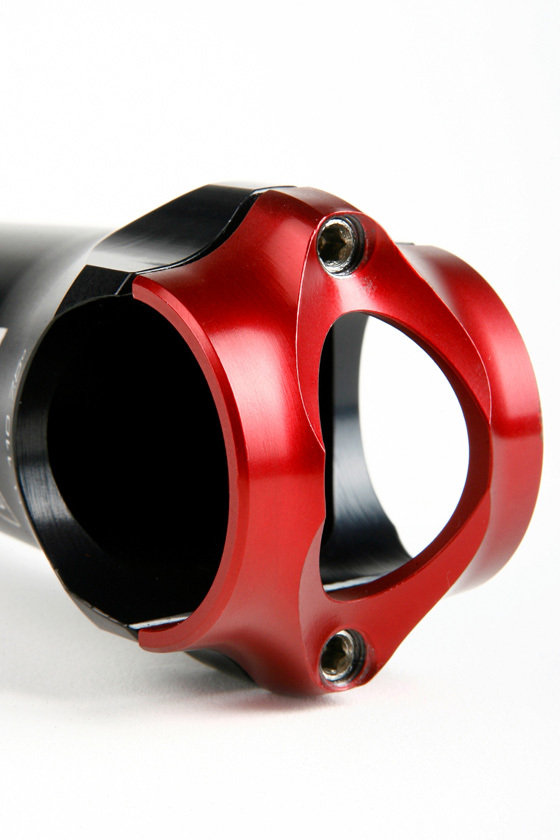
This stem is already available from 90mm to 130mm per 10mm steps. The weight is within 99g in 90mm and 115g in 130mm, the bars clamping area is 31.8mm of diameter. The price is 110 euros.
Andrey Kashechkin used this stem during the Tour de France.
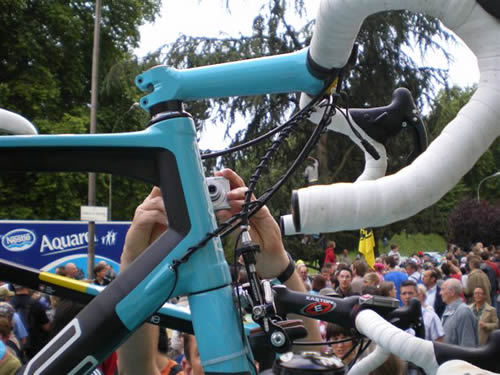
Rotor will propose also a seatpost for 2008. The informations about it are very light: we only know that the materials and treatments are the same as the stem. The seat rail grips are in option in
titanium or aluminium.
Then, the Agilis crank arms will be proposed in red as well for a high visibility!
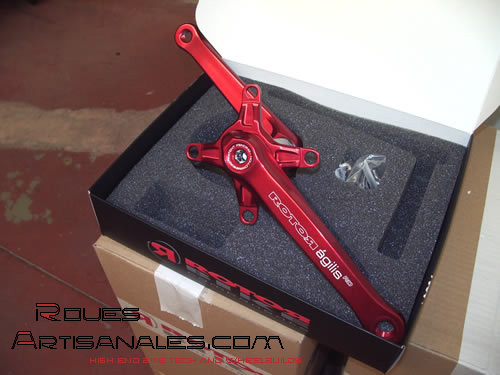
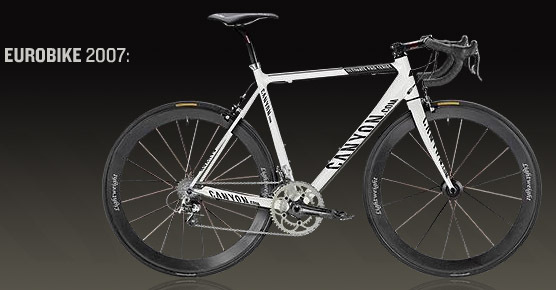
WH-7850 C50 TU
WH-7850 C24 TU
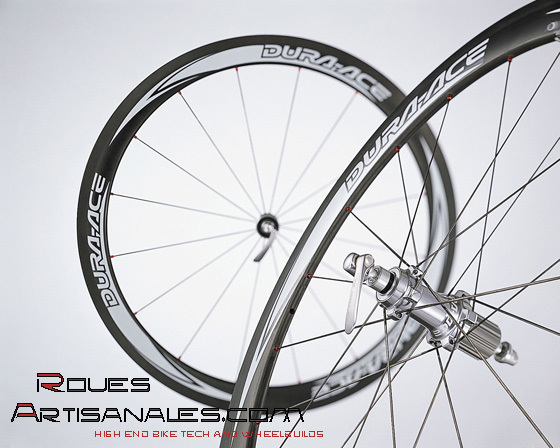
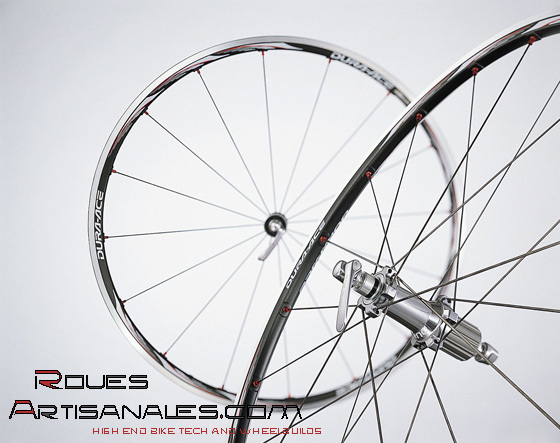
WH-7850 C24 CL
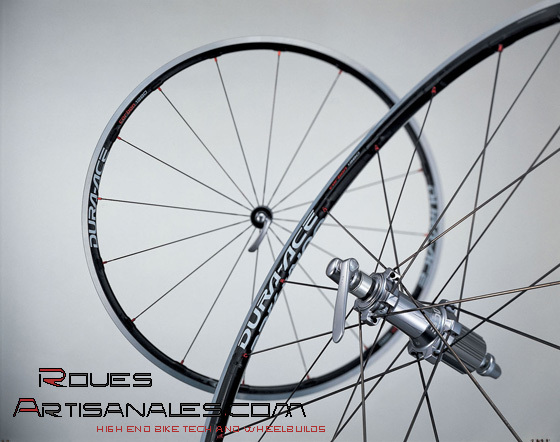

The new Pinarello Prince Carbon is used since almost two months by the Pro Tour team Caisse d’Epargne. It has been redesigned and gets several strong arguments notably in the aesthetic department! It is made out from a new 50HM1K carbon fibre. This very thin weave has a tensile strength of 50 tons per square centimeter. This strength has allowed Pinarello to reduce the amount of carbon used and thus the total weight without sacrificing the stiffness, the resistance or stability at high speed. The frame weights in under 900g (claimed), putting it amongst the lightest available.
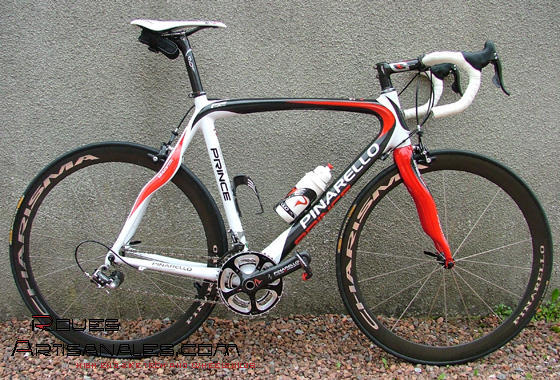
Pinarello has turned a corner in the development of bike frames with this new model. They gained a new level of insight into how tension and compression forces stress a frame under racers’ strength. The fibers and ribs are strategically oriented to reinforce, stiffen, increase bike stability at high speeds while keeping the touch of comfort and vibration absorption.
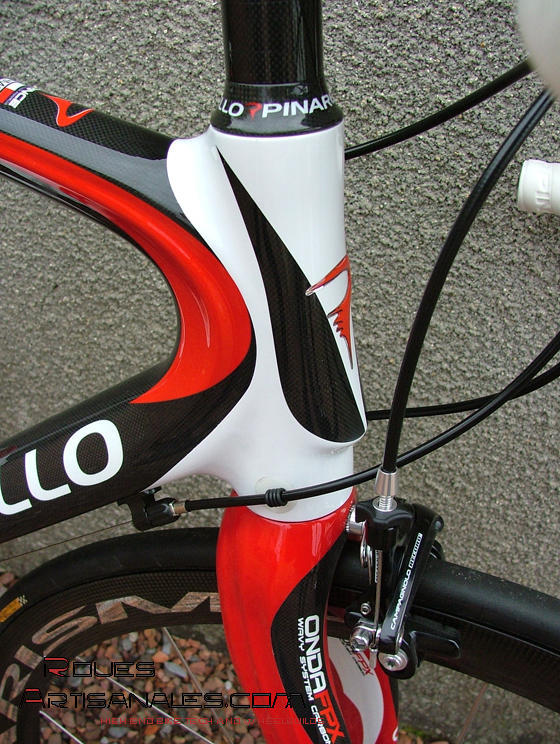
The Onda FPX fork uses the same carbon fibre as the frame. It has an extra "wave" compared to the current Onda, which is supposed to improve vibration absorption. Lateral ribs increase the stiffness which powerful riders will appreciate. The dropouts are entirely in carbon. This saves weight and the fibers continue to the tips of the structure.
The headset is integrated to the frame with 1" 1/2 diameter at bottom and 1" 1/8 on top.

The bottom bracket area is oversized as most of the frames nowadays for superior stiffness. Pinarello’s crankset is a modified and relabelled FSA K-Force. It has the particularity to use the same weave as the frame – the 1K. Most of the Pinarello components are actually based on standard manufacturers’ components but with slightly different specifications and improvements.
The Charisma wheels, for example, are Corima Aero but the rims are reworked. The lack of roundness at the fiber junction is invisible and imperceptible. The wheel is "rounder".

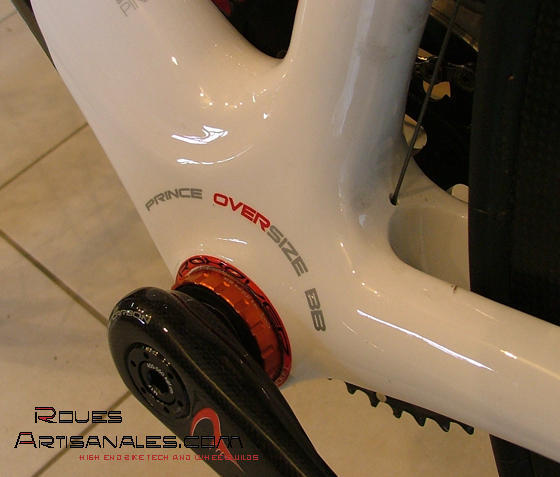
The rear triangle still uses the famous waved and curved seat stays. They are now ribbed as well. The chain stays are incredibly wide and symetric to further reduce the weight and optimize the stiffness. The dropouts are in carbon, like the fork.
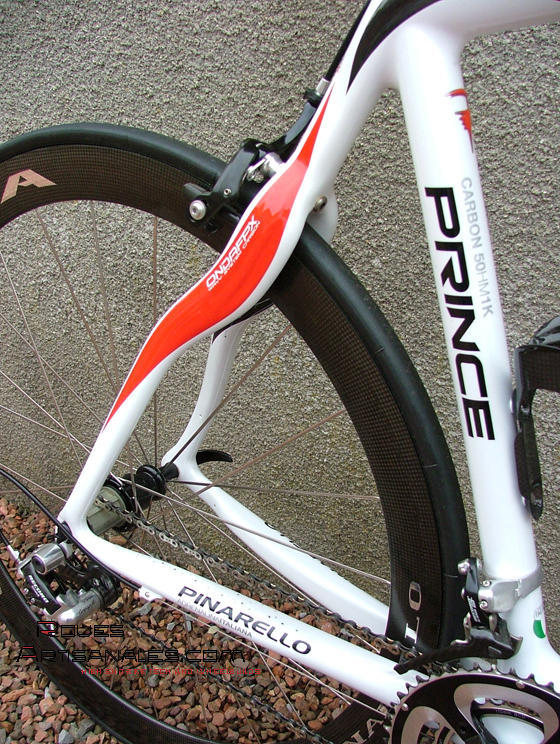
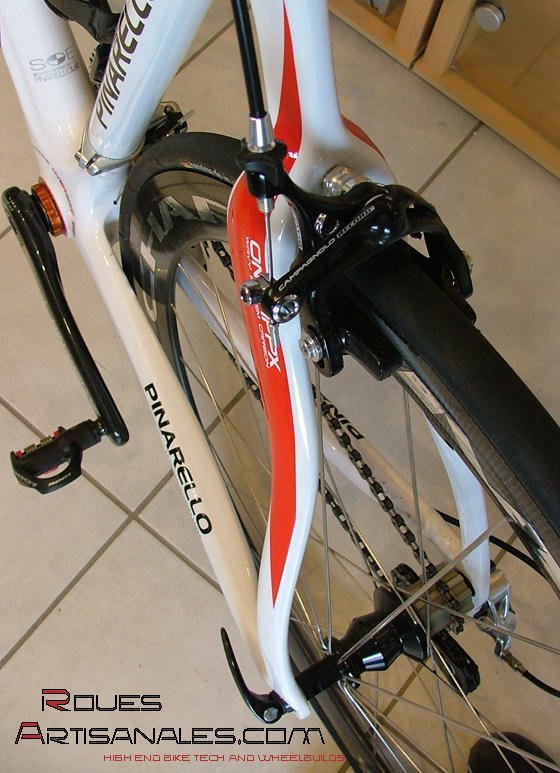
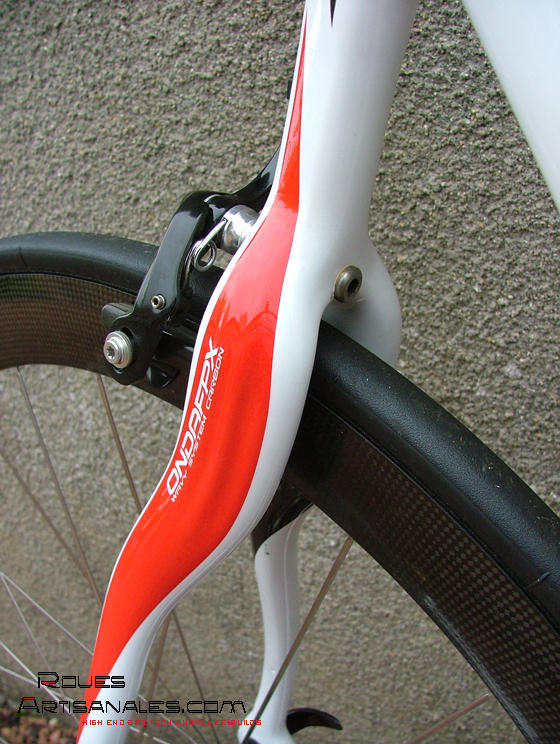
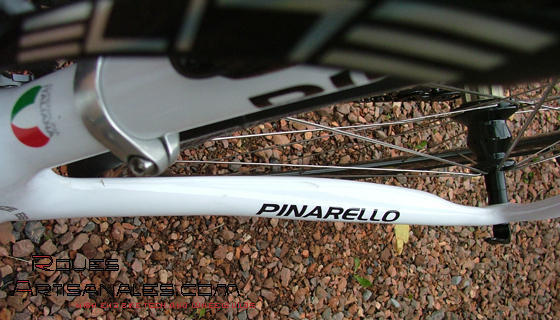
The frame is available in 10 sizes from 44 to 59,5cm. It comes in 4 colors: red, yellow, neon and Caisse d’Epargne. Last but not least, a custom paint programm "My way" is available for the afinionados!
Prince website.
Thanks to Cycles Pagliccia at Berlaimont.

Tune hubs have been improved over the last years. The current rear hub range officially includes the Mag150, the Mag160 and the Mag190. They all weight more or less, the figure of their name.
Uli Fahl crossed a new a limit, which still could be considered reasonable, with new freewheels. They are machinned down to the bare minimum that is required to position the cassette. Considering the power delivered by the riders, only 4 splines are enough to transfer the torque from the cogs to the hub sheel. Eight splines were superfluous since half of them only prevented the cogs to lose contact with the splines that transfer the torque.
Tune Mag190 weight sometimes crossed 190g for the lightest versions with the former rotor.
Troy Watson, the wheelbuilder of LigeroWheels could receive some of the new hubs. With this new freewheel, the Campagnolo versions hit the scale at 182/184g and the Shimano versions 185/188g, which is a big step forward! Maybe the Mag190 will be called Mag180 soon! Some years ago, the Mag180 were the highest range model with a carbon axle…
At the same time, the Mag160 will hit the scale with 160g (previously 168g) and the Mag150: 153g (previously 161g). In Campa version of course.
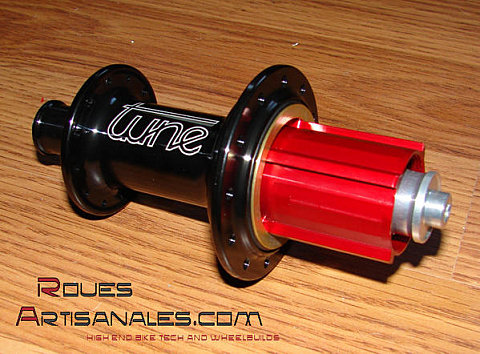
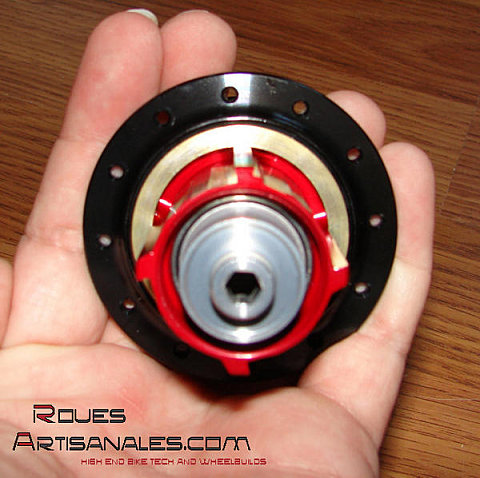

The Lightweight Generation 2 have been unveiled almost one year ago. Lighter and stiffer than the previous model, the success is obvious since the shops and even the distributors are delivered sparingly.
This difficult situation will certainly last since a couple new models are being tested and will be unveiled soon. This should boost and increase the interest in these uncommon wheels.
Thus, several models are already in final test phase:
If the weight of the Challenge 700 is well confirmed, there is a lot to bet some new materials are used to keep stiffness and solidity. This high-end model will konck out the competitors…
We are waiting for further technical information and an official confirmation of the clincher version. Anyway we can be sure this will be one of the most interesting topic in the following weeks.
During the SparkassenCup, earl in June in Germany, racer Joerg Ludewig (Team Wiesenhof Felt) were using a prototype laced with brand new spokes. The Kevlar, which brought softness and deformation resistance, seems to be abandonned for the highest stiffness.
Carbon-Sports confirms the spokes are not simply painted black. Are those the Challenge 700? We will have a reply in a couple of weeks at the Eurobike!

Voici déjà une année que le fabricant français Time a acquis le brevet de Guy Frullani, "inventeur-créateur" des roues du même nom. Bien que profondément modifiées, les roues Time disposent toujours, d’une partie des spécificités qui ont fait la renommée des roues brevetées en 1997.
Avant de présenter en image ces nouvelles roues, voyons concrétement quels sont les les avantages de ce concept breveté.
– Sur une roue de vélo traditionelle, les rayons sont coudés et subissent donc un stress inutile à cause de la tension du rayon au niveau du coude. Sur les roues Frullani, les rayons sont droits. Rien de bien nouveau mais durant les années 90, ce n’était pas très commun.
– A cause des nombreuses vitesses: les parapluies des roues arrières traditionelles sont différents des deux côtés de la roue. Ceci oblige un fort déséquilibre des roues arrière. Le concept Frullani réduit le parapluie côté opposé roue libre: il approche les rayons vers le centre de la roue, et augmente celui côté roue libre. Jusqu’à obtenir un parapluie identique des deux côtés, synonyme de roue parfaitement équilibrée. Or, le nombre de vitesses est rapidement passé, à l’aube du 21ème siècle, à 7 ou 8 puis 9 et 10. Le concept perdait alors tout son sens puisqu’il était impossible d’obtenir des parapluies identiques sans sacrifier en conséquence la rigidité latérale de la roue. Le déquilibre était alors inévitable.
Sur les dernières roues Time, le déséquilibre est moindre qu’un roue classique mais n’est pas nul.
Croquis du moyeu arrière original Frullani
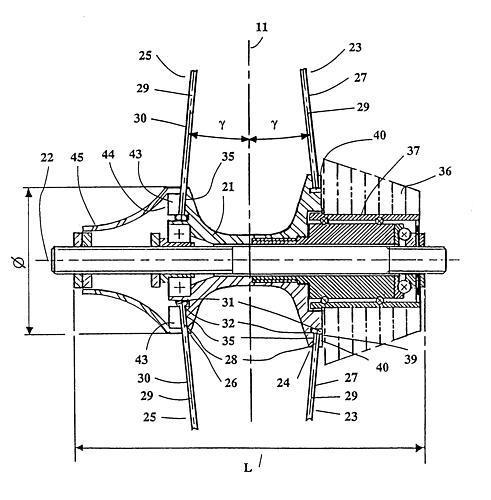
Les jantes
Time s’est ainsi offert ce concept l’an dernier et l’a fait évoluer., notamment par des moyeux en carbone, offrant rigidité et esthétisme. Les roues baptisées Hi-Tense à cause de la tension élevée disposent de jantes de 22 et 25mm de hauteur. Le poids de la paire est annoncé à 1530g, pas forcément léger, surtout pour des roues à jantes plates. Nous espérons que les prochaines versions à jantes carbone seront plus attractives.
Les moyeux
Le corps des moyeux est donc en carbone. Des inserts en aluminium permettent de visser les écrous des rayons et d’insérer parfaitement les roulements. Les axes des moyeux sont en carbone à l’avant et en aluminium à l’arrière.
Le mécanisme de roue libre dispose d’un engagement très rapide avec ses 42 dents. L’accélération se réalise donc tous les 8°. A titre de comparaison, les moyeux Tune ne disposent que de 36 dents, soit d’un engagement tous les 10°. Minime différence mais bon point tout de même pour les roues Time.
Les rayons
Les rayons au nombre de 20 à l’avant et 24 à l’arrière sont profilés, ils ont été fabriqués en collaboration avec Sapim. Leurs dimensions sont de 2.3-1.8-2.3 pour l’avant et l’arrière et 2.3-2.0-2.3 à l’arrière côté droit. En ce qui concerne les tensions, le rapport est quasiment de 1 soit 150kg côté roue libre et 140kg ou 120kg côté opposé (suivant le système Shimano et Campagnolo). Sur des moyeux à flasques classiques, le rapport est de 1/2 (150kg, 75kg par ex.).
Une extrémité du rayon se visse dans le moyeu tandis que l’autre se bloque contre la jante. La roue est donc réglable, dévoilable par l’intermédiaire d’une simple clé BTR par cette extrémité.
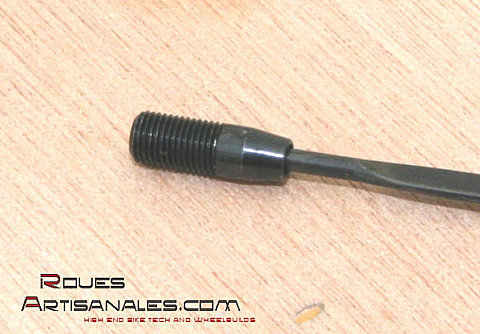 Cliquez pour agrandir Photo ©: Gonzalo/arueda.com |
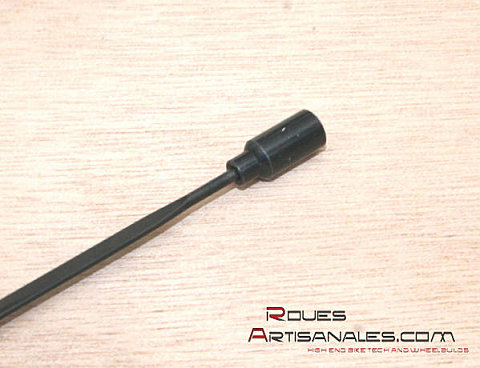 Cliquez pour agrandir Photo ©: Gonzalo/arueda.com |
La rigidité
En théorie, à cause du faible parapluie, la roue arrière est peu rigide latéralement. La forte tension des rayons, bien que redardant le point de flambage du rayon (voyez plus d’informations sur l’article des Mavic R-sys) ne permettra pas de compenser le faible parapluie. Time promouvoie ses roues comme les plus rigides sur un test réalisé face à une roue aluminium de 1510g et une autre carbone de 1150g. N’ayant pas plus d’informations sur le type de roue, ces informations sont difficilement crédibles, d’autant plus que les tests viennent directement du fabricant… Affaire à suivre!

The french manufacturer Time bought Guy Frullani‘s patent one year ago. Frullani is the "inventor/creator" of the famous wheels of the same name. Even through Time deeply modified his concept, they still use some specifications of the wheels patented in 1997.
Before presenting the new wheels’ pictures, let’s clarify in concrete terms what are the breakthrough of this patented concept.
– The conventionnal wheels spokes are bent. They have to deal with useless stress because of the spoke tension around this bent. Frullani’s wheels use straight pull spokes to avoid this stress. This is not new but in the nineties this was not really common.
– Because of the numerous speeds, the bracing angles of standard rear wheels are different on both sides of the wheel. This causes an unbalanced wheel. Frullani’s concept reduces the bracing angle on the non-drive side: he brings the spokes closer to the center of the hub. He increases too the drive-side bracing angle until he gets the same angle on both sides of the rear wheel, which is synonymous of perfectly balanced wheel. Then, at the dawn of the 21th century, the speeds number got higher. Thus, the concept lost its sense since it was impossible to keep equal bracing angles without sacrificing consequently the lateral stiffness of the wheel. The unbalance was inevitable.
The latest Time wheels are unbalanced but still more balanced than a standard wheel.
Drawing of Frullani original rear hub

The rims
So Time bought this concept the last year and upgraded it with carbon hubs providing stiffness and look. The wheels, which are called Hi-Tense because of their high spoke tension, have 22 and 25mm alloy deep rims. The wheelset weight is claimed to be 1530g, which is not very light, especially when you consider they have flat rims. We hope the next versions with carbon rims will be more attractives.
The hubs
The hubs bodies are in carbon. However, there are two inserts in aluminium to screw the spokes and to fit the bearings with high precision. The axles are in carbon at the front and in aluminium alloy at the rear.
The freewheel mechanism has a fast engagement because of the 42 teeth. The accelerations are realized every 8°. As comparizon, Tune hubs only have 36 teeth, meaning an engagement every 10°. This is a small difference but it’s a good point for Time.
The spokes
The aero spokes are 20 at the front and 24 at the rear. They have been made in relation with Sapim. Their size is 2.3-1.8-2.3mm for both the front wheel and the rear wheel non drive-side, the drive-side rear wheel has 2.3-2.0-2.3mm spokes. About the tensions, the balance is almost 1: 150kg on the rear wheel drive side and 140kg or 120kg for the the non drive-side (it depends on the system Shimano or Campagnolo). With classic flanged hubs, the balance is usually around 1/2 (150kg, 75kg for ex.).
A tip of the spoke is screwed in the hub while the other one pulls the rim. Thus the wheels are still truable thanks to a hex key one can insert at this tip.
 Click to enlarge Photo ©: Gonzalo/arueda.com |
 Click to enlarge Photo ©: Gonzalo/arueda.com |
The stiffness
Theoretically, because of the low bracing angle the rear wheel is not very stiff lateraly. The high spoke tension should delay the spoke bending when a lateral load is applied (see this article about the Mavic R-Sys) but it certainly won’t compensate the low bracing angle. Time promotes his wheels as being the stiffest from a test realized against an aluminium wheel of 1510g and a carbon one of 1150g. We don’t have any more information about the kind of wheel it is. This information is then hardly credible, all the more since the tests were performed by the manufacturer… to be continued!

Mavic a introduit, mi février, une nouvelle paire de roue qui sort des sentiers battus. Après une période de tests intensifs de plus d’un an, les roues
ont sillonné l’asphalte du Tour de France l’an dernier, en guise de test final. Nous avons couvert avec enthousiasme les diverses évolutions des roues et les phases de tests pour présenter en avant
première, ces nouvelles roues full carbone, ou presque.
Comme vous avez pu le constater, ce train roulant ressemble étrangement à son cousin germain: les Lightweight de Carbon-Sports. Il y a fort à parier que le procédé de fabrication soit assez
proche au vu des similitudes. En tout cas, les rayons s’enroulent de la même manière autour du moyeu. C’est une certitude. Toutefois, les différences entre les deux sont bel et bien présentes.
Alors, pâle copie ou véritables améliorations, nous nous efforcerons de porter un jugement objectif sur ces CCU en exposant leurs avantages et
inconvénients.
Comme toutes les pièces carbone haut de gamme, les délais sont très longs. Même si la presse a parfois quelques privilèges pour obtenir des produits à l’avance, force est de constater que pour le
client lambda final, les délais sont toujours excessifs. Mavic, Lightweight, Lew racing pour les roues, THM, BTP, Ax-Lightness pour les composants, tous annoncent des délais atteignant plusieurs
semaines, voire plusieurs mois. C’est la raison pour laquelle nos tests de roues prennent tant de temps à être finalisés.
Les Cosmic Carbone Ultimate affichent un poids officiel de 1185g. Avec une fine couche de colle durcie, notre paire atteint 1200g. Ce qui s’avère léger, mais nous sommes loin des 920g des
Lightweight ou des 880g des Lew. La trame de carbone utilisée ici est la 12K qui offre une meilleure tenue dans le temps mais aussi une résistance aux chocs moins bonne que les premières versions,
en 3K. Cette trame s’impose, avec le temps dans l’industrie du vélo, pour des raisons d’approvisionnement et de coûts.
| La fibre de carbone 3K pour les roues de test | |
|
Cliquez pour agrandir |
Cliquez pour agrandir |
En ce qui concerne le rayonnage, l’avant et l’arrière disposent de 20 rayons. Le côté opposé roue libre de la roue arrière, est un peu spécial puisque les rayons sont radiaux et disposent d’un
système de réglage. Nous en reparlerons plus bas.
Les roues dont nous disposons sont des pré séries datant de février/mars, les versions commercialisées disposent d’un esthétisme revu à la hausse.
Les Cosmic Carbone Ultimate utilisent des jantes à profil haut de 40mm de hauteur pour 21mm de largeur. La forme des jantes est légèrement incurvée et devrait, en théorie, apporter un
meilleur aérodynamisme qu’une jante triangulaire comme celle des Lightweight. Cette hypothèse sera vérifiée en soufflerie dans les semaines qui suivent.
En ce qui concerne la jante arrière, elle est asymétrique pour réduire le déséquilibre entre les tensions des rayons des deux côtés de la roue arrière. L’asymétrie atteint environ 3 à 4mm, ceci est
considérable et permet d’utiliser un parapluie assez large sans trop compromettre l’équilibre des tensions de la roue. On se rend compte de cette conception par le trou de valve moulé qui se trouve
décalé.
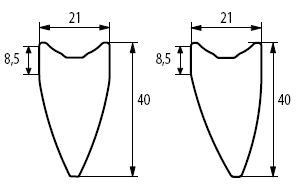
Avant
Le moyeu avant est entièrement en carbone, d’une fibre similaire à celle de la jante. La forme est particulièrement travaillée puisqu’il ne s’agit ici pas d’un simple tube. Au centre la section est
très fine ce qui se traduira en léger avantage aérodynamique. Cette partie centrale est collée aux flasques et un léger trait de marqueur indélébile est appliqué pour masquer la colle. Nous pouvons
discerner, entre le flasque du moyeu et le cache extérieur des trâces de colle et de mousse, ce qui semble exactement identique à ce que l’on peut constater sur les Ligthweight.
En terme de finition, ces roues sont en deça de leur concurrent direct Lightweight, alors que nous n’étions déjà pas trop emballés par leur finition. Diverses griffes, rayures et imperfections sont
visibles. N’oublions pas que ces roues sont finies à la main et la paire dont nous disposons est l’une des premières sortie de l’usine. Avec le temps, l’esthétisme devrait s’améliorer et peut être
venir chatouiller les allemandes. Voyez plutôt sur les photos qui suivent les différences en terme de finition et les similitudes en terme de fabrication.
| Les moyeux des mavic CCU et des Lightweight Obermayer | |
|
Cliquez pour agrandir |
Cliquez pour agrandir |
Arrière
Le moyeu arrière est en alliage d’aluminium. C’est assez surprenant quand on a conscience du niveau de gamme auquel ces roues sont destinées. Il s’agit sans doute d’une porte ouverte aux évolutions
futures… d’autant que des modèles à moyeux carbone ont été utilisés par les professionnels lors du Tour 2006. Ils ne disposaient pas du système de réglage. Certes, mais un moyeu en fibres
composites aurait sans aucun doute pu être conçu pour accueillir ce système. Ou inversement, le système aurait pu être modifié pour s’adapter aux caractéristiques d’un moyeu carbone. La roue aurait
gagné quelques dizaines de grammes.
Bref, ce moyeu arrière est réalisé en deux parties. Le corps principal qui comprend le flasque côté roue libre est usiné pour insérer les écrous de rayon du système de réglage lors du montage. La
deuxième partie accueille véritablement les écrous lorsque la roue est montée entièrement. Entre ces deux parties, une bague fine s’intercale pour bloquer fermement les écrous. Ingénieux, mais la
look global de la roue en prend un sacré coup.
Nous aurions préféré un système plus discret avec des écrous entièrement noirs pour coordonner l’équilibre visuel général. D’une pierre, deux coups, l’aluminium aurait allégé le dispositif
(actuellement en laiton) et aurait pu être anodizé pour assortir la couleur noire des roues.
Au niveau de la géométrie, la distance entre les deux flasques qui conditionne en grande partie la rigidité de la roue, est de 55mm. A titre de comparaison, les Lightweight affichent 58mm et les
Lew Pro VT1, 60,61mm. La distance entre les flasques du moyeu des CCU est donc la plus faible des 3. Cependant n’oublions pas que la jante est asymétrique: 3mm de décalage.
|
Cliquez pour agrandir |
|
|
Cliquez pour agrandir |
|
|
|
Cliquez pour agrandir |
Formés de fibres de carbone unidirectionnelles, les rayons entièrement noirs affichent des caractéristiques fort intéréssantes: deux fois la résistance d’un rayon traditionnel inox de
diamètre 1,8mm pour 35% de poids en moins, à taille égale. Pour la roue avant, les rayons sont moulés dans la jante, enroulent le moyeu puis rejoignent la jante à quelques centimètres du point
d’origine, à l’instar du cousin germain.
En ce qui concerne la roue arrière, ce procédé de fabrication n’est utilisé que du côté roue libre. Côté opposé, les rayons radiaux sont moulés dans la jante puis vissés au moyeu via un écrou,
comme un roue presque conventionelle. Ce système permet d’obtenir une roue réglable en voile et en saut ce qui s’avère intéressant quand le procédé de fabrication est encore perfectible.
A propos de la tension des rayons, la roue avant n’est pas très tendue. En revanche les rayons de la roue arrière sont de véritables carreaux d’arbalète, et ceci, des deux côtés!
Le point d’insertion du rayon dans la jante
La question mérite d’être posée. Le dispositif de réglage tranche avec le look général et ajoute de l’embonpoint. Pourquoi la roue arrière en est-elle équipée alors que la roue avant s’en
passe?
A celà plusieurs réponses et hypothèses, dont une qui sort évidemment du lot. La jeunesse du procédé de fabrication ne permet pas des roues d’une précision excellente, surtout pour une roue
arrière, entraînant un parapluie non symétrique. La roue avant qui s’avère pourtant plus aisée à réaliser n’est déjà pas parfaitement droite ni ronde, il y a donc fort à parier qu’un système de
réglage sur l’arrière était indispensable pour assurer une roue avec un minimum de précision…
Sur le papier, le modèle haut de gamme du constructeur français dispose d’atouts fort intéressants face à la majorité des roues du marché. Pourtant, face au son concurrent direct Lightweight,
ses atouts se réduisent au seul critère du tarif (300 euros de moins). En tout cas, en théorie. Nous nous déplacerons à Annecy chez Mavic fin Juillet ou courant Août pour décortiquer chacune des
roues de A à Z: inertie, rigidité latérale et frontale, aérodynamisme, résistance au roulement. Nous espérons d’agréables surprises!

Pourquoi la forme du moyeu avant a-t-elle été modifiée après le Tour 2006?
M.L: Le moyeu actuel est beaucoup plus aérodynamique et n’était pas prêt pour le Tour 2006.
Un moyeu arrière en carbone aurait été plus sympa, pourquoi avez vous utilisé l’aluminium?
M.L: Le moyeu arrière est en aluminium pour des raisons mécaniques. Un moyeu identique en carbone aurait atteint un poids supérieur à cause des interfaces alu/carbone pour le nez de moyeu FTS-L
(ndlr: système de roue libre) et à cause du système de réglage côté opposé roue libre. De plus, les délais et budgets de conception et de recherche et dévelopemment n’auraient pas été
respectés.
Pourquoi pas de l’aluminium anodisé noir pour le système de réglage?
M.L: Les écrous en laiton sont simplement plus fiables qu’en aluminium. Quant à la couleur noire, les designers n’ont pas cherché la discretion sur ce système de réglage, bien au contraire.
Vous utilisez bien du marqueur pour masquer les imperfections et surplus de colle sur le moyeu avant?
M.L: Il arrive que du marqueur soit utilisé, comme chez tous nos concurrents. Ceci dit, nous en utilisons de moins en moins d’une part, et quand nous en utilisons, il est maintenant plus
discret.
Nous avons du être très patients pour obtenir ces roues, plusieurs mois. Est-ce que les clients devront attendre aussi
longtemps?
M.L: En ce qui concerne les quantités livrées, nous sommes en période de démarrage de production. Toutes les commandes sont concentrées en même temps dans le monde entier. Il nous faut donc
absorber ce pic. Ensuite, vers la fin de l’année 2007, nous serons capable s’assurer des délais similaires à nos autres roues de la gamme. Qui peut en dire autant?

Mavic introduced mid-February a new wheelset that is different to the norm and whet they have produced in the past. After an intensive testing period
that lasted more than a year, the wheels saw the Tour de France roads as a final test last year. We covered enthusiastically each successive evolution and the tests of these brand new full carbon
fibre wheels (almost full) in a preview showing.
As you will notice, these hoops bear a striking similarity to the Lightweight wheels from Carbon-Sports. The manufacturing process should be very similar, judging by the visual look of these
wheels. For instance, the spokes are wrapped around the hub, that is sure. However, upon closer inspection the differences between both of them are definitely present.
So is this a pale imitation; does it really bring interesting features and changes? We’ll compare them to bring a fair judgement about the CCU, while also
presenting their pros and cons.
As any high range carbon part, the delays are excessive. Although the press sometimes have exclusivity, we had to wait several weeks before getting this set. We can’t imagine how long it could be
for the final customer. Mavic, Lightweight and Lew Racing for wheels, THM, BTP, Ax-Lightness for the components; they all announce delays of many weeks, sometimes many months. It’s the reason why
our tests take so long to be performed.
We are owning a pre-serie wheelset from February/march. The last versions are better finished.
The Cosmic Carbone Ultimate claimed weight is 1185g. Including a thin dried layer of sement, our set is 1200g. This is light but we’re far from the Lightweight at 920g and the Lew at
880g.
The weave used here is 12K, which provides longer life, but a lower impact resistance than the 3K one used for the testing wheels. This 12K weave is more and more used nowadays in the bike industry
because of availability and low cost.
| The 3K carbon fiber for the testing wheels | |
|
Click to enlarge |
Click to enlarge |
About the spokes. Both the front and the rear have 20 spokes. The rear wheel non-drive side spokes are a bit special since they are laced radially and they have a truing system. We’ll speak again
about this further.
The Cosmic Carbone Ultimate use high profile 40mm rims. Their width is 21mm. The shape of the rims, which is slightly curved should provide better aerodynamical properties than a triangular
rim such as the one used for the Lightweight. This hypothesis will be verified in a wind tunnel in the following weeks.
About the rear rim, it is asymetrical to optimize the spoke tension balance. The asymetry is around 3 or 4mm which is significant. Conseqiently, using a high bracing angle is not really an issue.
We can verify/realize this design from the moulded valve hole, which is offset.

Front one
The front hub is entirely made of carbon. This is the same weave as the rim. The shape is particularly worked this way since this is not a simple tube: the center is narrower for better aerodynamic
properties. This middle part is bonded into the flanges and we have noticed some permanent marker to hide the glue. One can discern some residual glue and foam between the two parts of the flanges,
same as can be found on the Lightweight. It shows how close to Lightweight wheels the CCU’s process is.
About the finish: this hub is not as nice as pleasing aesthetically as its direct competitor (i.e Lightweight) which was not perfectly finished either. On the hub of this CCU, we noticed several
scratches and imperfections. The wheels are finished by hand and the set in our possession was one of the first produced. With time, we believe the aesthetic should normally improve and be more on
a par with the Lightweight’s.
Feel free to have a look at the following pictures to see the differences in term of finish and the similarities in term of manufacturing process.
| Mavic CCU and Lightweight Obermayer hubs | |
|
Click to enlarge |
Click to enlarge |
Rear one
The rear hub is made from an aluminium alloy. This is quite surprising considering the range level the wheels are destinated for. They certainly leave an open door for further improvements. Some
carbon hubs rear wheels were test ridden by the Cofidis pro riders during the 2006 Tour de France. They didn’t have the truing system, certainly, but a carbon fibre hub could have been designed to
accomodate the system if it was really useful. Conversly, the system could have been modified to fit the peculiarities of a carbon fiber hub. For instance, some grams would have been saved on the
wheel.
In short, the rear hub is made in two parts. The main body that includes the drive side flange, is machined to fit the truing system nipples during the build process. The second part really holds
the nipples when the wheel is completed. Between these two parts a thin ring firmly blocks the nipples. This is ingenious but the wheel look is not as cool.
A less obtrusive and more discreet system with all black nipples would have matched better the general look. The hardware is in brass. Aluminium parts could have killed two birds with one stone
while bringing lightness and a black anodization.
Geometry. The distance between the hub flanges that is synonymous with stiffness, is 55mm. As a comparizon, the Lightweight width is 58mm and the Lew Pro VT1 are 60,61mm. Mavic CCU flange to
flange width is lower than the two competitors but there is also the 3mm asymetry of the rim to take into account.
|
Click to enlarge |
|
|
Click to enlarge |
|
|
|
Click to enlarge |
Made out of unidirectional carbon fibres, the black spokes bring interesting characteristics: they have twice the resistance of a standard 1.8mm round spoke, and a weight reduction of
35%. The front wheel spokes are moulded inside the rim, then wrapped around the hub then go back to the rim, a few centimetres from their starting point.
This concept is used only for the drive side of the rear wheel. The non-drive side spokes are moulded inside the rim and then screwed to the hub via a nipple, just like a conventional wheel. This
system allows a wheel that can be trued, which is interesting when the manufacturing process can still be perfected.
With regard to spoke tension, the front wheel is not that tight. However, the rear wheel spokes are incredibly tight on both sides.
Insertion point of the spoke inside the rim
The question has to be asked. This system breaks the aesthetic lines and adds weight. Why is the rear wheel equipped with this while the front one isn’t?
There are several answers and hypotheses, but one reply is obvious. The relatively early time in the manufacturing process of these wheels shows that there is a lack of precision, especially for a
rear wheel that doesn’t have equal bracing angles. However, it is likely that this will improve over time.
The front wheel which is easier to build is not perfectly round nor true either. Thus, a truing system was chosen for the rear wheel to guarantee decent precision…
In theory, this high range of wheels from the French manufacturer and its financial wherewithal, means it can match itc competitors. However, against its immediately direct competitor
(Lightweight), its only advantage is the price (300 euros less). This, is in theory of course. We will visit Mavic in Annecy by the end of the month or early August to fully evaluate each wheel
for: inertia, lateral and frontal stiffness, aerodynamism, bearing resistance.

Why was the front hub shape modified after the 2006 Tour?
M.L: The current front hub is faster but was unfortunately not ready for the 2006 Tour.
A carbon rear hub would have been cooler, why did you use aluminium?
M.L: The rear hub is made out of alloy for mechanical reasons. A similar hub in carbon would have been heavier because of the alloy/carbon interfaces for the FTS-L engagement system and the
truing non drive-side system. Moreover, the delays and budgets of design and research and development would not have been respected.
Why didn’t you use black anodized for the truing system?
M.L: Brass nipples are more reliable than alloy ones. About the black color, the designers didn’t choose a stealth truing system, they looked for something visible.
You use a permanent marker to hide the imperfections and glue left over?
M.L: We sometimes use some permanent marker, as all our competitors. However, we use it less and less, and when it’s used, it’s now more discreet.
We have had to be very patient to get the wheels, many months. Will every customers have to deal with such long delays?
M.L: About the quantities, we’re starting the production. Every orders are concentrated at the same time in the whole world. We have to absorb this peak. Then, by the end of the month, we will
be able to guarantee the same delay as any wheel of our range. Who can do that well?

Fulcrum, illegitimate Campagnolo‘s son, renews his high range wheelset. Here is the latest evolution of the Fulcrum Racing Zero. For 2008, in order to match any frame color (or almost any), a version with a black rim and red spokes is born.
Let’s remind quickly the characteristics of them:
– entirely made out of aluminium alloy
– flat rims: 26mm
* the top bridge is not drilled to keep a high stiffness and to avoid using rim tapes
* the material thickness is reduced between the spokes, where there is no stress to enlighten the wheels
– 16 aluminium front spokes and 21 aluminium rear spokes
* 2:1 concept, two times more spokes on the drive side than on the opposite side to balance the spoke tensions
– cups/balls bearings a la Record
– 1465g the set

Après presque une semaine de Tour, nous avons pu frissonner au rythme des échapées dans lesquelles les français ont joué un rôle primordial. Déjà deux longues échappées au compteur de Sylvain Chavanel de l’équipe Cofidis qui, au passage ôte le maillot de meilleur grimpeur des épaules de Stéphane Augé. De son côté Laurent Lefèvre de Bouygues Telecom a durci la fin de course.
Shimano EDA
Dans le précédent article concernant le Tour, nous vous avons présenté le groupe électronique eRecord de chez Campagnolo. Shimano est aussi en plein test, grandeur nature, de son groupe EDA (Electronique Dura-Ace). Jettez un coup d’oeil sur la photo, ci dessous, de Ronny Scholz, équipe Gerolsteiner.

 Photo ©: James Huang/Cyclingnews.com
|
 Photo ©: James Huang/Cyclingnews.com
|
Mavic
Lors du prologue à Londres, Mavic a fourni à l’équipe Saunier Duval Prodir une roue avant Io avec une trame différente du modèle standard. Celle ci dispose d’une fibre 12K, comme sur les Cosmic Carbone Ultimate ou les Corima Aéro au lieu de la fibre 3K qui, soulignons le au passage, tend à disparaître.

Quelle est cette roue?
En ce qui concerne la roue avant qui équipe ce Specialized, c’est l’énigme totale. Une jante carbone d’environ 40mm de hauteur et des rayons carbone gris, qui semblent moulés à la jante. Dommage que le photographe n’aie pas pris le moyeu aussi, nous aurions eu plus d’indices…
Oserions nous avancer que c’est un prototype réalisé par Mavic? 


The Tour started almost one week ago, we could shiver all along the breakaways in which the french guys played an essential role. Sylvain Chavanel from Cofidis team were already present in two long breakaways and took off at the same time the king of mountain jersey from Stéphane Augé shoulders. In the meantime, Laurent Lefèvre from Bouygues Telecom hardened the end of the race.
Shimano EDA
In the previous article related to the Tour, we presented you the eRecord electronic groupset from Campagnolo. Shimano is life-size testing his EDA groupset (Electronic Dura-Ace). Have a look at the following picture from Ronny Scholz, Gerolsteiner team.

 Photo ©: James Huang/Cyclingnews.com
|
 Photo ©: James Huang/Cyclingnews.com
|
Mavic
During the prolog in London, Mavic provided Saunier Duval Prodir team an Io front wheel with a special weave. It is built with a 12K carbon fiber, as the Cosmic Carbone Ultimate or the Corima Aero while the 3K fiber, seems to diseappear.

What’s this wheel?
About the front wheel of this Specialized, it’s an enigma. A carbon rim, approximately 40mm deep, with grey carbon spokes that seem molded into the rim. So bad the photograph couldn’t take the hub too, we would have had more clues…
Would we dare to say it’s a prototype realized by Mavic? 


Cette année, le marché du cycle a vu l’apparition de deux nouvelles paires de roues axées très haut de gamme. En guise de contre face à la suprématie de Carbon-Sports et de ses Lightweight, Lew Racing a annoncé le 27 janvier ses Pro VT1 et Mavic, les Cosmic Carbon Ultimate le 15 Février. Toutes deux disposent d’atouts de taille, qu’ils soient axés matériaux, technique, service ou tarif pour essayer d’intimider les Lightweight, valeurs sûres et reconnues depuis des années.
Seulement voilà, sur ses dernières roues, Mavic a simplement modifié le concept des Lightweight de Heinz Obermayer par un réglage de la roue arrière et des moyeux de forme et matériaux différents. Le principe est toujours le même: les rayons sont moulés dans la jante et s’enroulent autour des moyeux. En cas de bris de rayon, les roues sont alors inutilisables, bonnes pour la benne! A plus de 2300 euros pour les Mavic et 2600 ou 3600 euros pour les Lightweight Standard et Obermayer, l’addition est plutôt salée…
|
Rayon cassé près de l’encoche du moyeu
|
|||
|
L’avantage des roues Lew Racing réside justement en la possiblité de remplacer n’importe quelle pièce: les rayons, le moyeu ou même la jante. Ceci est rendu possible par un procédé de fabrication totalement différent des deux autres roues mentionnées ci dessus. Ici, les rayons sont collés dans les encoches de la jante et des flasques du moyeu via un agent spécifique. Ils assurent l’intégrité et la rigidité de la roue quand le procédé de fabrication prend fin. Ce dernier est donc relativement simpliste, dans l’absolu, mais tellement avantageux! En effet, lorsqu’un rayon est accidenté, Lew Racing le dégage par chaleur, par pression interne et en appliquant diverses forces. Un produit réactif permet de nettoyer toute trâce de colle à l’interface rayon/moyeu et rayon/jante. |
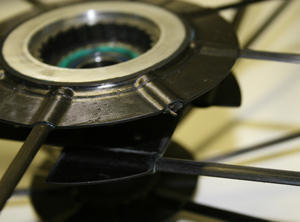
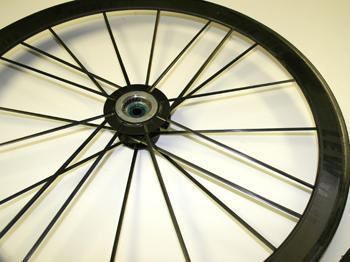
|
||
|
Rayon réparé |
|
|
Puis un rayon neuf est replacé, recollé, comme s’il été destiné à une roue neuve. Par la suite, un test sur route et divers contrôles garantissent une roue à la precision redoutable. |
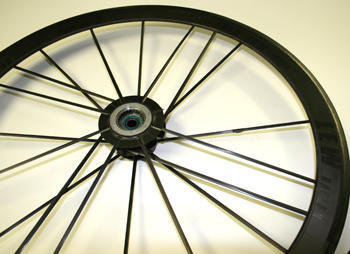
|
En guise de comparaison, vous pouvez vous rendre compte des spécificités des trois constructions différentes par le tableau ci dessous:
| Lew Racing PRO VT1 | Lightweight Generation 2 | Mavic Cosmic Carbone Ultimate | |
| Jantes | – 46mm de hauteur – Carbone / Bore -230 g – Epaulement générateur de turbulences |
– 53mm -Carbone 3K – environ 290-320g |
– 40mm – Carbone 12K – assymétrique à l’arrière |
| Rayons | -16 avant / 20 arrière -Carbone / Bore – Forme aérodynamique issue du comité NACA (aéronautique) – 3g |
-12-16-20 avant / 20 arrière -Carbone / Kevlar |
-20 avant / 20 arrière -Carbone – Réglage du voile d’un côté de la roue arrière |
| Moyeux | – Carbone / Bore – 3 flasques à l’arrière, les deux extérieurs pour la rigidité, celui du centre pour transférer le couple – axes bore, 15mm de diamètre |
– Carbone 3K pour les deux moyeux – axe avant aluminium 15mm de diamètre, axe arrière carbone 15mm de diamètre |
– Carbone 12K à l’avant – Aluminium Arrière – axes aluminium, 9mm de diamètre |
| Type de fabrication | Laminage / Collage | Laminage / Moulage | Laminage / Moulage |
| Patins carbone | Non | Oui | Oui |
| Poids de la paire | 880 à 920g (version Shimano et Campagnolo) | 915 à 1090g (version hyper légère Obermayer en 12/20 et version Standard en 20/20) | 1185g |
| Réparation | Chaque pièce est interchangeable, un programme d’extension de garantie de 4 ans "sans question posée" pour un remplacement complet est disponible pour 1000 dollars US | Jante réparable dans certains cas. Sinon, réduction de 30% sur une roue neuve | Programme d’extension de garantie MP3, remplacement total sous certaines conditions |
| Prix | 4100 euros | De 2600 pour les Standard à 3600 euros pour les Obermayer | 2300 euros |
– Aérodynamisme
Sur ces roues, tout semble pensé et étudié dans les moindres détails. Un épaulement "générateur de turbulances" améliore l’aérodynamisme de la jante de 46mm de hauteur. Les rayons suivent les standards NACA aéronautique, toujours dans l’optique de générer une traînée minimale.
|
Cliquez pour agrandir |
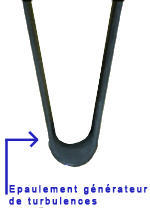 |
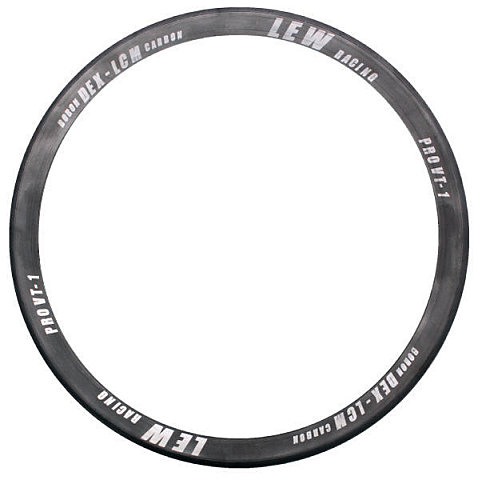 Cliquez pour agrandir |
|
– Transfert du couple
Une autre avancée sur ces roues concerne le moyeu arrière. Pour transférer le couple, habituellement nous croisons les rayons de la roue arrière le plus possible pour qu’ils s’approchent au maximum de la tangente imaginaire d’un transfert de couple dit "parfait". A cause du parapluie, ils ne sont pas dans le même plan que la jante, ne travaillent pas uniquement en traction et stressent donc inutilement. Avec cette construction spécifique, la roue arrière dispose des avantages d’un fort parapluie apportant la rigidité et d’un parapluie nul transférant le couple à la perfection…
| Le moyeu arrière: 3 flasques | |
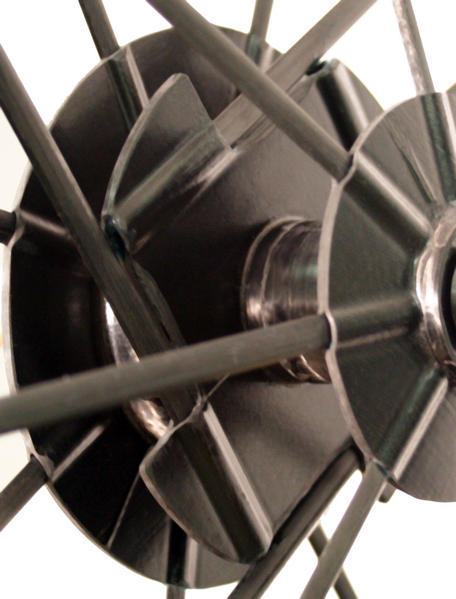
|
Le moyeu arrière dispose de trois flasques: les deux flasques extérieurs sont très éloignés (60,61mm, sur les Lightweight il est de 58mm et sur les Mavic CCU il est de 55mm) et accueillent des rayons radiaux au moyeu pour une rigidité maximale tandis que le flasque central accueille les 4 rayons surdimensionnés (25% de section supplémentaire). Tangents au moyeu, ils transfèrent le couple moteur généré par le coureur. Ce dernier flasque est placé parfaitement dans l’alignement de la jante pour que ces 4 rayons ne subissent que des efforts de traction. |
|
Cliquez pour agrandir
Photo ©: Fairwheelbikes.com
|
Cliquez pour agrandir
Photo ©: Fairwheelbikes.com
|
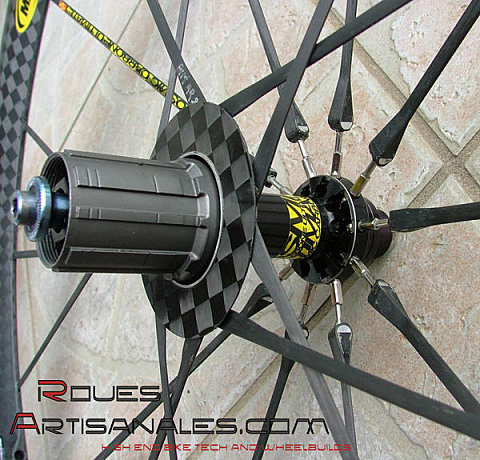 Cliquez pour agrandir
Photo ©: Fairwheelbikes.com
|
|
|
Cliquez pour agrandir
Photo ©: Fairwheelbikes.com
|
|
– Une rigidité excellente, sur le papier
Une chose est sûre, en théorie ces roues sont très rigides. Ceci pour plusieurs choses. La première, due à l’architecture, est la grande distance entre les deux flasques du moyeu. Elle permet de réduire les mouvements de jante entre les patins lors des accélérations. La seconde est due aux rayons. Introduits au fond des encoches du moyeu et de la jante, ils sont ensuite collés fermement dans leurs compartiments. Cinq fois plus rigides qu’un rayon traditionnel inox, ils résistent aussi trois fois plus à la compression et deux fois plus à la tension. Ceci leur permet de travailler en traction et compression (Mavic n’est donc pas innovateur à ce niveau) et permet de conserver de très faibles tensions de rayonnage sans compremettre la rigidité.
Nous attendons avec impatience ces roues pour les tests en laboratoire…
– Poids, inertie & robustesse
En plus de ces diverses spécificités introduites cette année par Paul Lew, le poids de la paire de roue se situe entre 880 et 920g… ce qui s’avère incroyablement bas. Ce poids peut être atteint grâce aux matériaux très nobles utilisés: le carbone, le bore et par une technique spéciale de fabrication: le DEX-LCM™ développé pour le département de la défense américaine.
En ce qui concerne l’inertie, les jantes des roues Lew pèsent seulement 230g alors que la hauteur est de 46mm. Les accélérations doivent donc être foudroyantes. A titre de comparaison,les jantes des Lightweight se situent entre 290 and 320g.
Pour finir avec un atout de taille par rapport aux concurrents, la tension de rayon est très faible. La roue reste donc droite, sans voile, sans saut, ni baisse significative de la rigidité et du rendement de la roue quand un rayon est brisé. Voici sans doute une autre avancée de taille dans le fonctionnement de la roue…
| Interview de Paul Lew (anglais, 11,8Mo) |
Ainsi…
les roues proposées par Paul Lew disposent d’un réel avantage sur les roues Lightweight et Mavic au design, certes très efficace mais vieillissant et presque impossible à réparer.
Mavic, avec son programme MP3, offre un remplacement des roues Cosmic Carbone Ultimate pour 185 euros. Carbon-Sports propose une remise de 30% sur une roue neuve. Ici pour les Lew, il suffit simplement de dégager puis recoller un rayon… bien plus avantageux pour le client et le constructeur!
Seul bémol, pour s’offrir ces roues, quelques centaines d’euros supplémentaires sont nécessaires!
| Démontage du moyeu arrière (11.8Mo) |
| Remontage du moyeu arrière (7.18Mo) |
– Aimant de compteur
 Cliquez pour agrandir |
Voici un petit détail utile, l’aimant de compteur est fournit avec la paire de Pro VT1 et est inséré sur un rayon. Il suffit de le glisser sur le rayon, en face de son émetteur puis de la coller avec de la colle forte.
Cliquez pour agrandir
|

The story is superb. It’s Mr. Eugen Allmendinger‘s one. Passionnated and relentless, he has serious abilities to work the carbon. During his free time, he enjoys making full carbon rear derailleurs… With one week of work to realize one piece, he is unable to follow what the customers and pernickety manufacturers need. Carbon-Sports bought the design.
Originale shape
These events happened already three years ago! Originnaly, after the purchase, the german wheel maker announced the derailleur to be available for summer 2006. However, at the Eurobike 2006 (earl in September, see at the bottom of the page), Stefan Behrens had to delay this date. The prototypes weren’t perfectly working yet. He could anyway present the work in progress. An alloy prototype of a different shape with interesting assets…
In short, today the derailleur functions. Some lucky beta-testers will be able to get an exemplary in the following days for the final validation. Official presentation planned for the Eurobike 2007!
The derailleur hits the scale with 119g in classic version… we’ll see with some carbon jockey wheels and a titanium spring.
Even though this criterion is merely subjective, the aesthetism is real sexy… we are really delighted.

Indeed, some journalists seem to get special privileges in the bicycle world. While Sram firmly embargoed the pictures of the latest Sram Red groupset, Velonews.com journalists could present in a preview showing some components of this groupset.
Well, it will not be used for the Tour de France by the Saunier Duval riders, contrary to what we expected.
The levers
The changes concern, as we mentionned in our precedent article, several important features in relation to the Force groupset:
* the material: the two levers are made out of unidirectionnal carbon fiber
* the shape of the braking lever changes, it is 1cm longer and slightly narrower
* the shifting lever gets shorter and narrower too
* an extra setting appears: the distance between the lever and the handlebar thanks to an angle adjustement (8°) of the lever
* the left shifter evoluates for two things:
– it has got three "clik" to adjust the derailleur
– for the first one, 11° have been shaved from the Force levers
* the weight is 285g

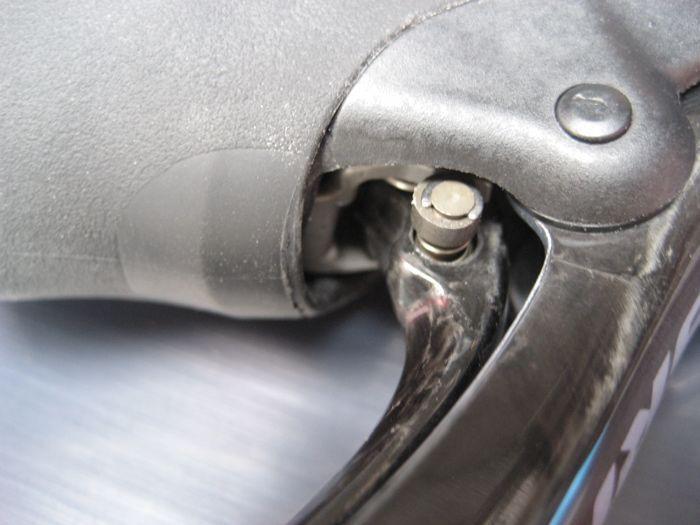
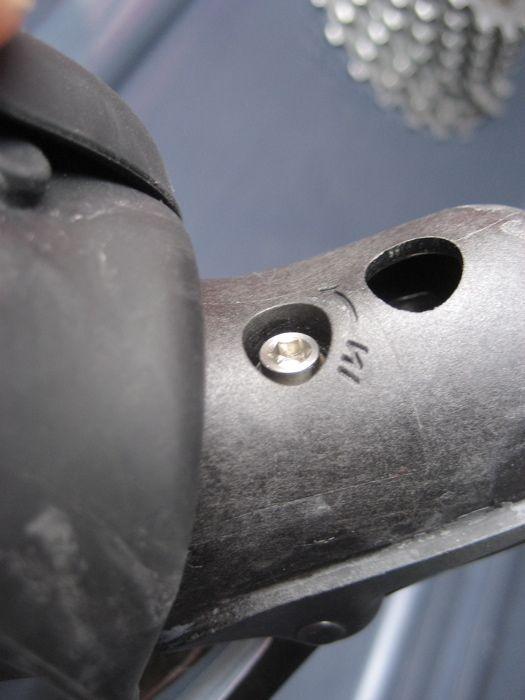
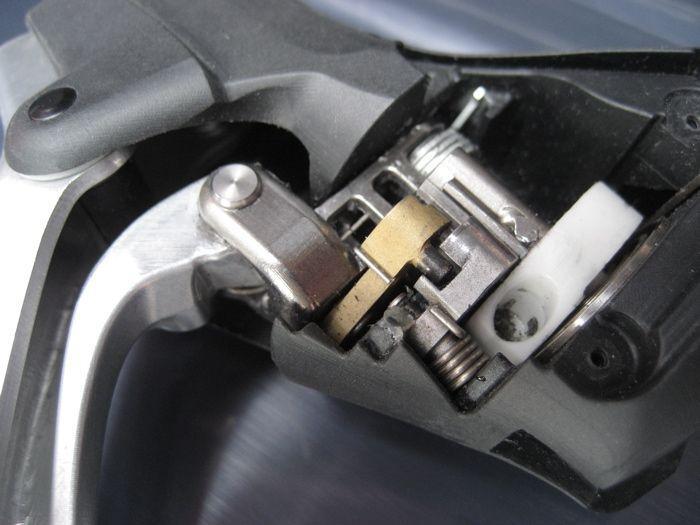
The cassette
Contrary to what we thouht, the cassette presented to our fellow members didn’t have the carbon spider.
Here, on the prototype, everything is in steel. The cassette is made out from a solid piece of steel milled and machinned out. Only the first and the last cogs are in contact with the rear wheel cassette rotor. The 8 intermediary cogs are somewhat "following" the first and the last one. This feature allows an ultra light 160g cassette, even through a common and cheap material is used.
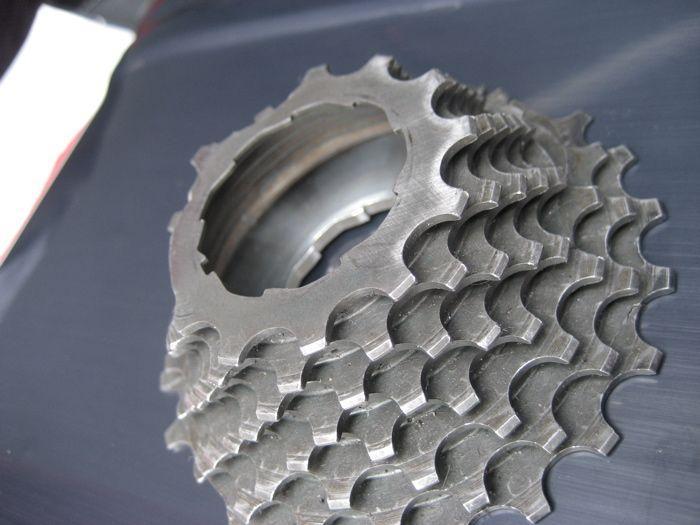
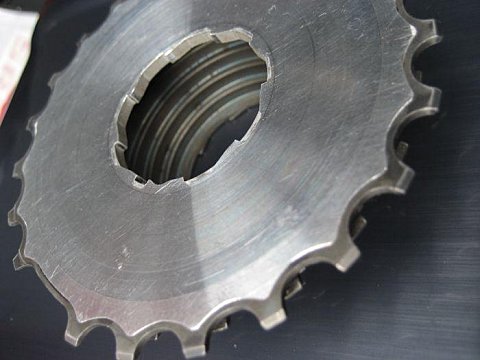
The rear derailleur
It indeed follows what is announced in the pdf that escaped from Sram offices! 🙂
In short, the pulleys wheels have ceramic bearings, the mech plates are in carbon. About the paralellogram, the external link is in alloy while the internal one is in carbon. The spring is in titanium, etc… In concrete terms, it’s specialized and light. The prototypes hit the scale with 150g.

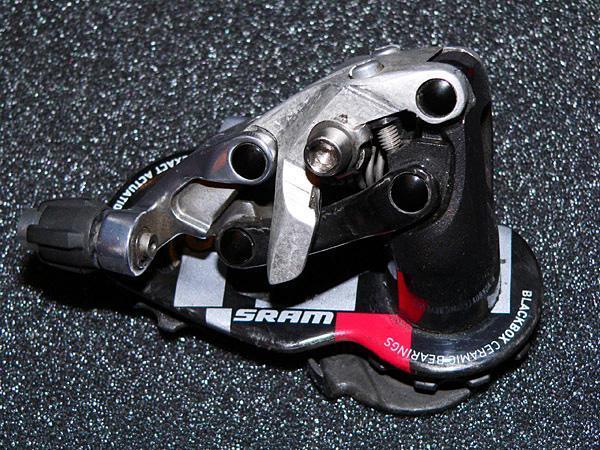

Photo ©: James Huang/Cyclingnews.com
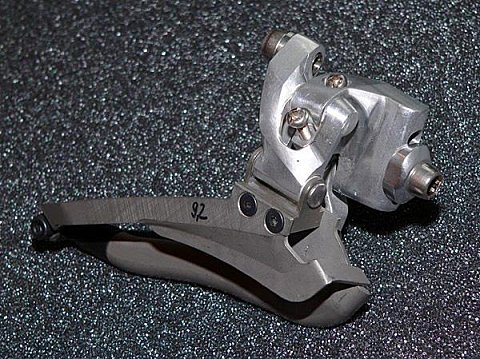

The chainrings
The chainrings look a lot like the Dura-Ace. As usually, the maximal stiffness has been a priority for the development, as well as the minimal weight since the backside is relieved.
About the crankset, we couldn’t see it yet. We hope it will be presented during the rest day of the Tour de France in Pau…

Photo ©: James Huang/Cyclingnews.com

2008 Specialized bike range has been presented to the american journalists a few days ago. It unveiled Sram Red groupset and several interesting new stuffs as well.
The main news concerns the new high range S-Works Tarmac SL2 frame, the S-Works Transition triathlon and time trial bike. Then, the Roval Alpinist SL 1060g wheelset, some accessories such as a new helmet, a pair of shoes and glasses have been presented too.
To start, here are the technical information about the "Tarmac SL2" that has been used by Tom Boonen during the Dauphiné Libéré.
With an exceptionnal stiffness, this frame has been conceived to transmit the 1.5 kilo watt of the flanders champion with no loss. Made out of composite material, this frame proposes some of the californian brand specificities. The fibers are very high modulus and the construction method blends monocoque and wrapped joint technology. The bottom bracket is huge, just like the diagonal tube and the very tall chain stays. It releases an impression of uncommon rigidity. The steering is oversized too, its dimensions are 1.5 inch at the bottom and 1"1/8 at the top. This kind of construction is fashion these days: the latest Trek uses a steering of the same size and Look with its 595 uses the same size at the top and 1.25 inch at the bottom. According to Specialized, the stiffness reaches a very high level, the bottom brackets actually gets 30% more compared to the current Tarmac. The vertical compliance is about 10% better too which is certainly caused by the new shape. The frame is claimed to be 952g in 56cm, the fork is 350g with uncut steerer tube.
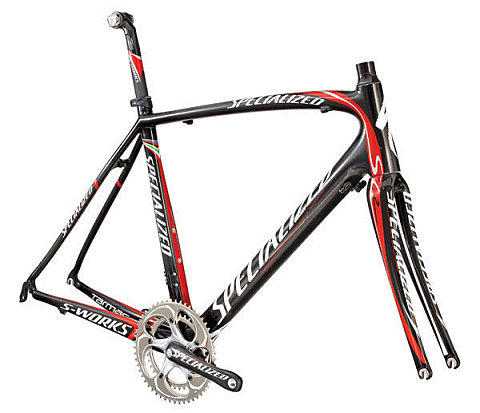
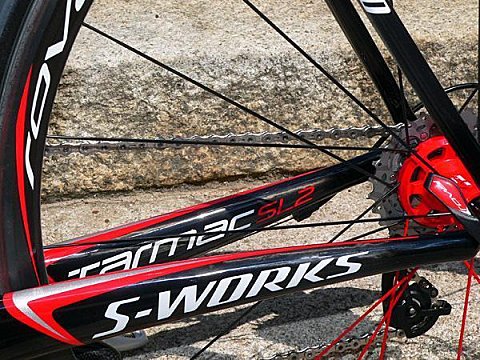

The "Transition" is the time trial frame. Every single shapes are deeply designed into details to reduce the drag as much as possible. The profile follows the NACA standards, just like the Lew wheels spokes for example.
Still in this objective, Specialized has hidden the rear brake caliper from the air flow and has integrated all the cables into the frame. Thus, it is close to what we saw on Leipheimer’s bike the last year. Beside this, a fourth tube is present to route an SRM powermeter wire. This extra brings a professionnal touch to the frame!
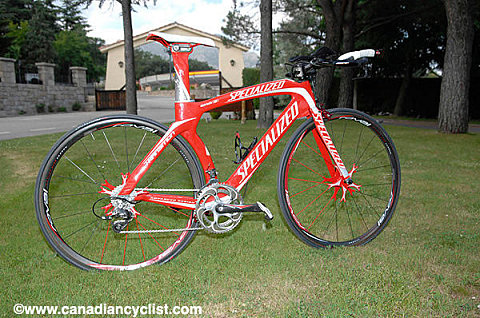
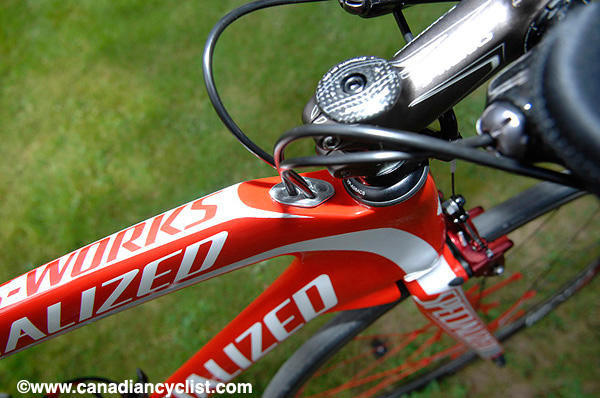
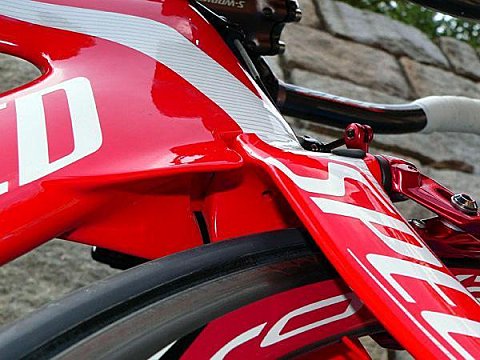
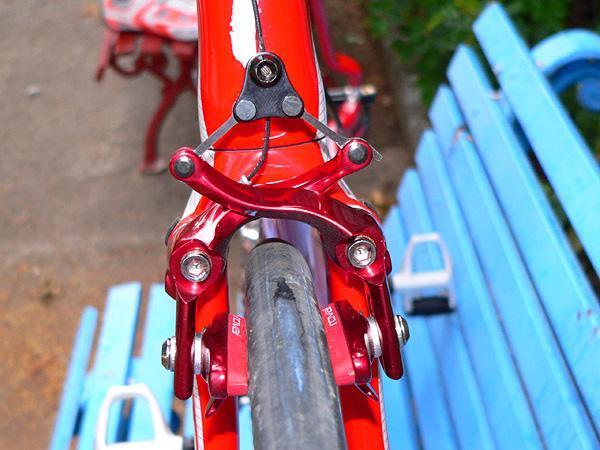
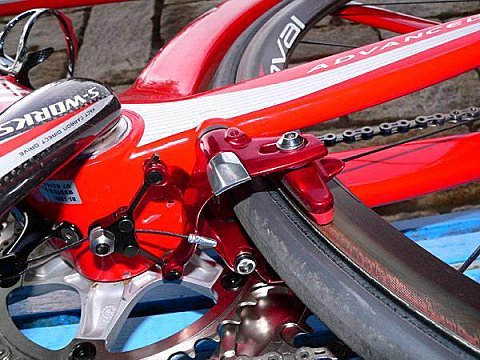
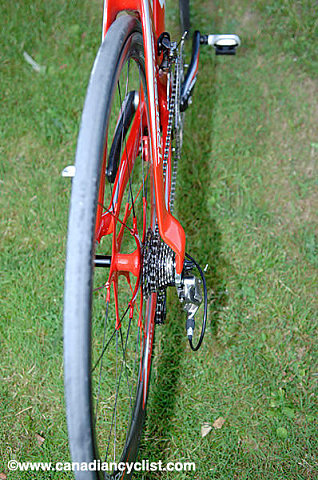
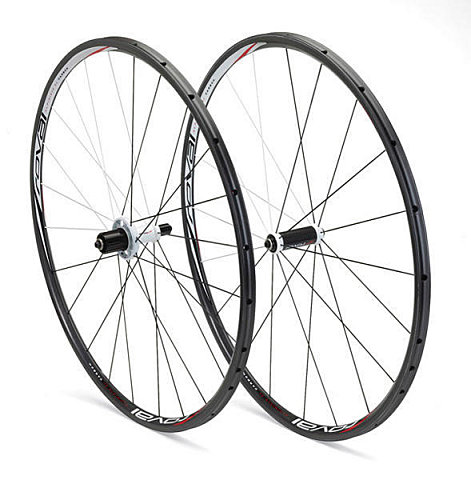
For the end, let’s speak about the accessories. The helmet integrates almost 20 meters of Kevlar reinforcements in the structure. The helmet weight only… 184g! Met already pushed the limit with its Stradivarius at 199g but this time, Specialized pushes the limits even further!
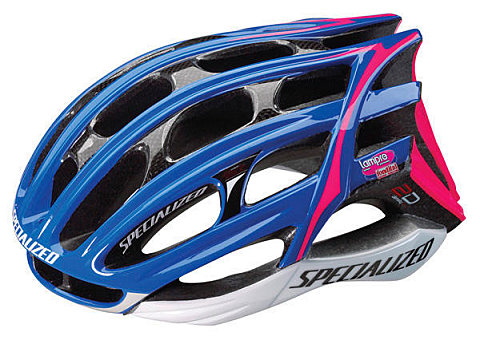
|
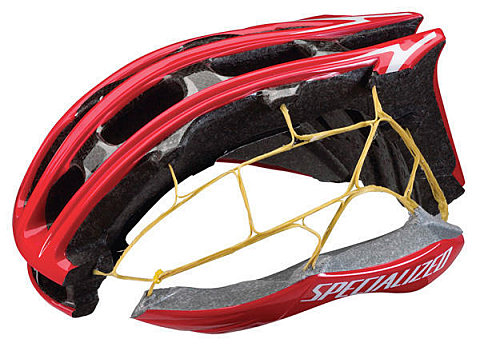
|
Regarding the shoes, they are super light too. 250g exactly. They turn out to be the lightest of the market. The sole is vented and the tightening system lets you adjust the pressure at differents places.
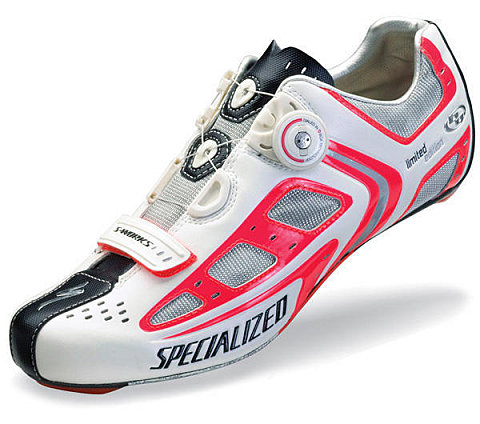
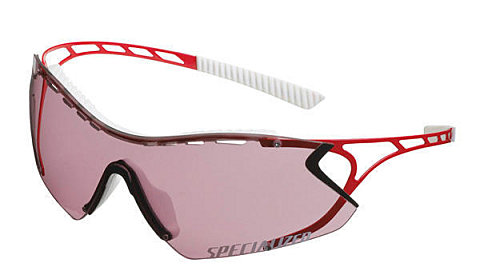

The handbuilt wheels presented on the site aren’t really common these days. Because they are often similar, a simple "copied pasted" would not be a good idea.
Today, you can finally have a look at this built that goes off the beaten tracks. A set of Lew Racing Pro VT1 rims laced to an M5 with no flange and a Tune Mag160. The spokes are, once again the traditionnal Cx-ray we won’t present anymore.
At only 290g for 46mm, and a maximal spoke tension of 200kg, these rims are definitely above what we can find on the market. Here, the hubs are 36 and 170g. Some weight saves are still possible in this area! About the building technic, the front spokes are straight pull head and are radial. The rear wheel ones are bent and crossed 2 times. Regarding the weight of the wheelset, with only 960 tiny grams, the stratosphere can be reached easily…
While selecting the lightest trio Lew rims, hubs and spokes, a 850g wheelset can be built with no difficulty. But still, to be raced or used with strong riders, the stiffness would certainly be too low. The ideal is to keep stiff spokes with a high bracing angle.
Front wheel:
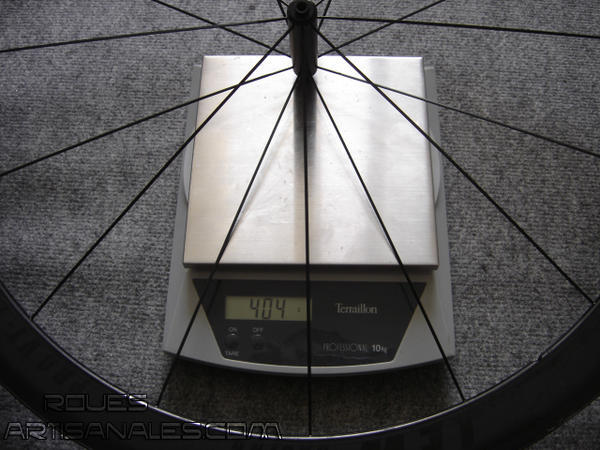
Rear wheel:
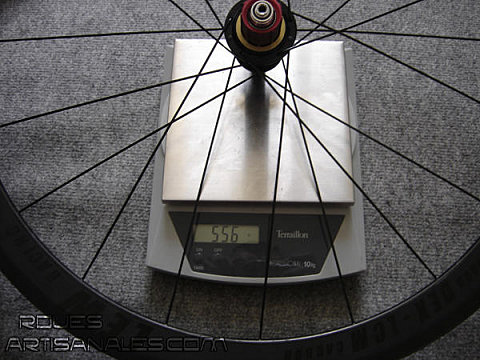
The set:
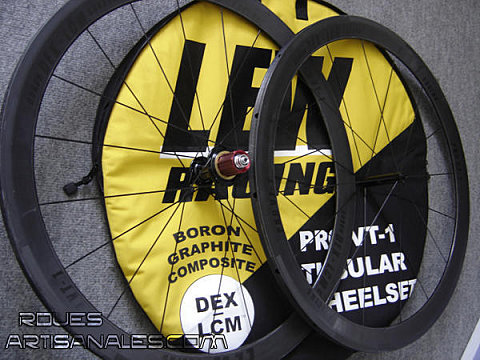

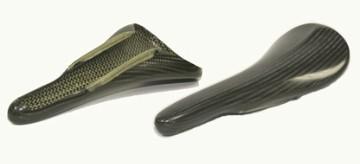
Ces derniers sont ainsi réalisés à partir de 43 couches de carbone compréssées sous 4 tonnes de pression pour former un tube de 6mm de diamètre. Ultra-résistant, les tests effectués pour évaluer la résistance au couple exercé par les vis de la tige de selle, les ont révélés bien plus résistants que ceux provenant d’autres constructeurs allemands… Concernant le confort, il sera excellent grâce à des couches supérieures assez souples.
Destinées à la route et au VTT, les selles n’affichent aucune limite de poids d’utilisateur. Le poids maximum prévu est de 90g. Les premiers modèles affichaient à peine 75g!
Pour finir avec le point le plus important, les selles sont customisables entièrement… en clair si vous voulez une couleur spéciale, une finition particulière, votre nom, votre équipe favorite ou encore de la publicité incrustée sous le vernis de la selle, c’est possible!
Ces selles seront dévoilées à l’Eurobike, mais seront disponibles dès cet été pour 199 euros. Prévoyez 20 euros de supplément pour la personnalisation.
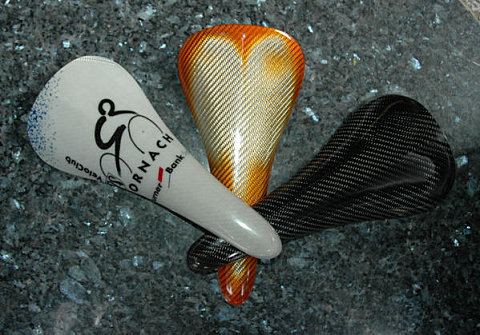
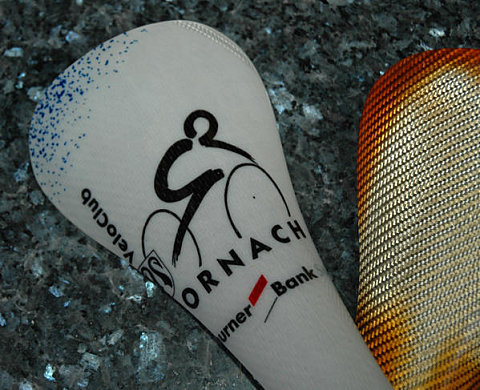
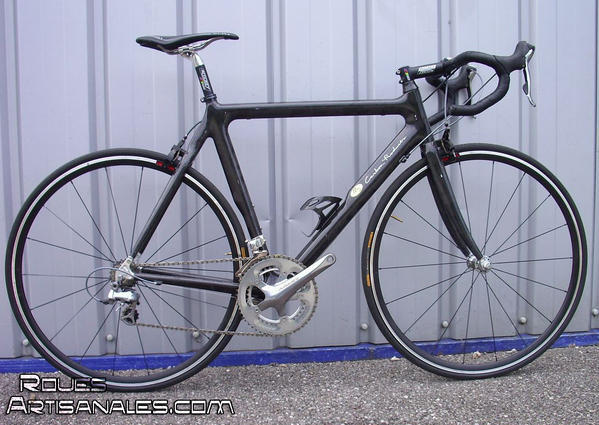
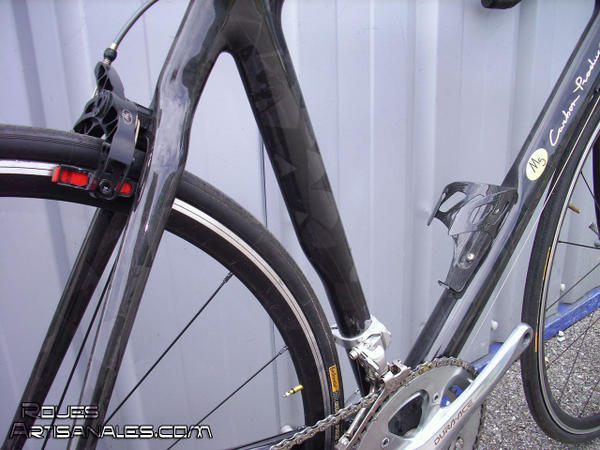
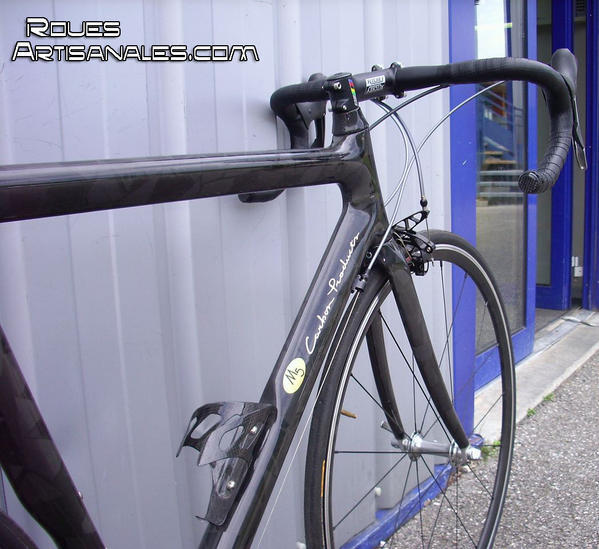
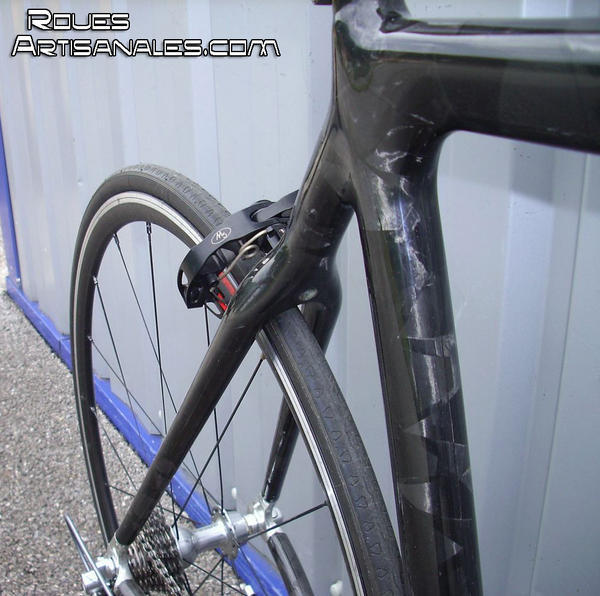
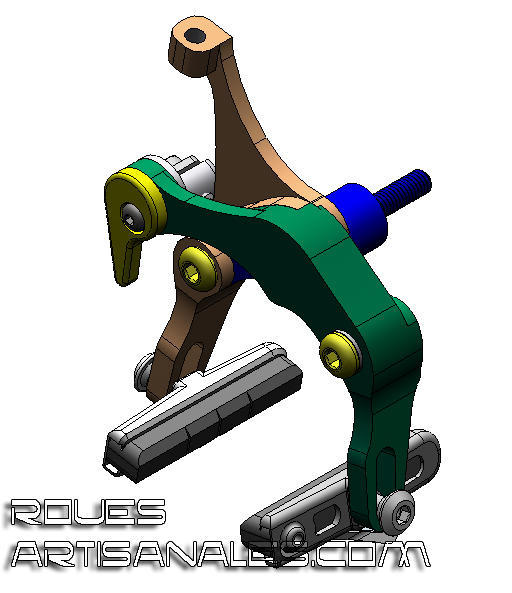


The rails are made of 43 threads of carbon pressed under 4 tons of pressure to give them a 6mm diameter. Ultra stiff and resistant, the tests performed to evaluate the torque resistance revealed them as being stronger than some saddles from other german manufacturers. About the comfort, the rails are being combined with softer upper.
Destinated to road or MTB, there is no rider weight limit . The maximal weight is 90g. The first samples came with a mere 75g!
Last but not least,the saddles are fully customizable… in concrete terms, if you need a special color, a particular finish, your name, your favorite team, or some advertisement into the resin, this is possible!
The saddles will be presented at the Eurobike but they are available from this summer for 199 euros. The customized version will 20 euros more expensive.








Invités à la présentation d’une nouvelle paire de roues au bord du lac d’Annecy, nous avons eu la chance de découvrir les nouvelles R-SYS bénéficiant du concept TraComp, déjà breveté.
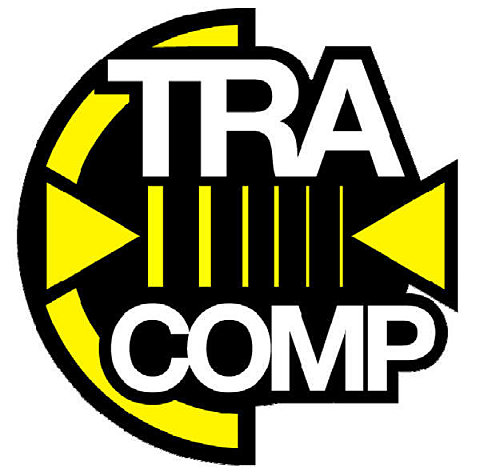
Concrétement, ce système s’avère totalement nouveau et remet en cause le fonctionnement d’une roue de vélo. Afin d’expliquer clairement le concept, il est nécessaire de rappeler le fonctionnement d’une roue conventionnelle.
Le fonctionnement d’une roue.
| L’intégrité de la roue est obtenue par tension des rayons. Chaque rayon tire la jante dans une direction et, la somme de toutes les tensions permet de solidariser la jante, le moyeu et les rayons/écrous. Lors d’accélérations, en danseuse ou en sprintant, une force latérale (F sur le dessin) s’applique sur la jante et la roue se déforme donc, plus ou moins en fonction de sa rigidité latérale. Les rayons situés du côté où la charge est appliquée se retendent (les rayons A sur le dessin) alors que ceux côté opposé perdent de la tension (rayons B).
Ci dessous, une photo de rayons détendus à cause d’une charge appliquée sur la jante. Cliquez pour agrandir
|
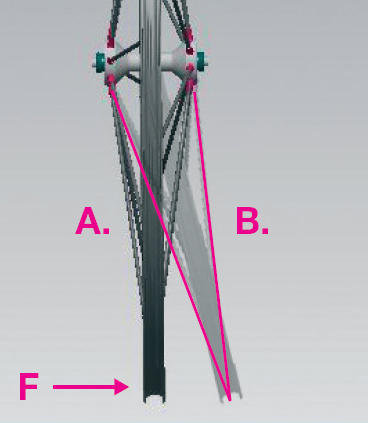
Photo © Mavic |
| Quand la charge appliquée est très importante, l’écrou du rayon quitte son appui (photo B) constitué par l’oeillet ou la paroi intérieure de la jante si elle est en carbone ou en aluminium sans oeillet. Première conséquence : dans la majorité des cas, l’écrou profite de ce mouvement pour se dévisser du rayon donc la roue voile. Deuxième conséquence : la roue perd beaucoup de rigidité car, seulement les rayons d’un côté de la roue résistent à la charge. |
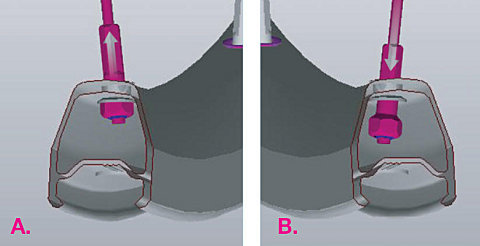
Photo © Mavic
|
Réaction à une charge latérale appliquée sur une roue utilisant le concept TraComp
Les rayons sont vissés sur la jante à l’instar d’une Ksyrium ES standard. Ils sont donc fermement bloqués et tout jeu dans le filet est rendu inexistant grâce à l’ajout d’un produit bloquant. Au niveau du moyeu, les rayons sont aussi bloqués par l’intermédiaire d’une bague aluminium, rigide et résistante à la compression.
Ainsi, lorsqu’une forte charge latérale est appliquée, les rayons censés être totalement détendus sur une roue conventionnelle entrent en compression. Ce phénomène est rendu possible par deux choses. L’utilisation de rayons très rigides. En carbone tubulaire, ils sont étonnamment plus rigides que des rayons standard en inox (par exemple) et, ne fléchissent pas sous la contrainte. Si des rayons plus souples avaient été employés pour ce système, ils auraient tout simplement « flambé » (fléchi), et le système se serait avéré inutile.
Ensuite, l’utilisation de basses tensions facilite l’entrée en compression du rayon. Avec des tensions très élevées, le concept se serait avéré inutile aussi puisque, les rayons qui se détendent à cause de la charge latérale resteraient toujours partiellement tendus.
Dernière spécificité du système, les faibles tensions stressent moins la roue et permettent d’alléger tous les composants.
Pour donner quelques chiffres, grâce à ce système, Mavic a pu baisser le poids de sa jante sous les 400g. Certes, il existe toujours plus léger pour des jantes aluminium mais, le standard pour une roue toute montée est dorénavant excellent.
Les rayons en fibre de carbone unidirectionelle sont ronds et creux, d’un diamètre extérieur de 4mm et intérieur de 2,6mm. Le poids est de 5g ce qui est similaire à un Cx-ray assez long (pour jante plate).
Le poids total de la paire de roues atteint 1355g en version pneus et 1340g en version boyaux.
Le système TraComp a la particularité de permettre une roue avec de faibles tensions dans les rayons. Ainsi, il est possible de concevoir une roue avec un parapluie plus large pour augmenter la rigidité latérale sans risque de déréglage ou de bris de rayon à cause du manque de tension. Par rapport à une Ksyrium ES, le "flasque" côté opposé roue libre est placé 4mm plus près de la patte de cadre.
La résistance à la traction des rayons est supérieure à ceux des rayons standard, elle grimpe a des valeurs de 300 à 500 daN contre 260 daN pour un Cx-ray. Leur raideur est exceptionelle et, permet notamment d’obtenir de bonnes valeurs de rigidité sur la roue complète. D’après Mavic, le rayonnage (le nombre de rayons et leur raideur) influe sur 36% la rigidité complète de la roue. A titre d’information, la jante ne joue que sur 10% maximum, et le parapluie sur près de 50%…
Pour gagner encore plus de rigidité, Mavic avait une autre solution: diminuer le diamètre intérieur de ses rayons, voire même utiliser des rayons pleins. La résistance au fléchissement aurait été augmentée de 18% mais la hausse de poids atteindrait 42% par rayon, soit 60g supplémentaire sur la paire de roue…
Pour donner des chiffres, la rigidité latérale de ces nouvelles R-SYS atteint 56N/mm à l’avant comme à l’arrière. A titre de comparaison, les Lightweight Standard atteignent, respectivement à l’avant et à l’arrière 60 et 43N/mm.
Pour démontrer ces chiffres, Mavic a eu la bonne idée d’apporter la machine testant la rigidité latérale des roues. Cette dernière est reliée à une table traçante qui, par l’intermédiaire de divers capteurs, enregistre et traçe la courbe de rigidité.
Voici les résultats obtenus pour plusieurs roues testées. La courbe représente le déplacement latéral de la jante sous une contrainte. La pente de la courbe représente donc la rigidité de la roue: plus la courbe monte rapidement, plus la roue est rigide latéralement.
La première courbe est celle de la R-SYS, il est évident qu’il s’agit de la plus rigide du test.
Les roues testées sont celles de journalistes présents ce jour là. ll ne s’agit pas de roues apportées par Mavic pour le test.
Un gain en confort ?
Il s’agit d’un paramètre peu important même si Mavic communique à ce sujet. La déformation verticale d’une roue est infime par rapport à la déformation d’un pneumatique, mais il est tout de même intéressant de savoir dans quelles proportions le changement d’architecture par rapport à une Ksyrium ES modifie la rigidité frontale.
Ainsi, à l’avant l’utilisation de ces rayons carbone durcit la roue puisqu’un gain de 100N/mm se fait sentir entre la Ksyrium ES et la R-SYS (de 1600 à 1700N/mm). A l’arrière, l’augmentation du parapluie permet d’augmenter les déformations et devrait, à l’usage, procurer plus de confort. La rigidité frontale à l’arrière est de 1400N/mm contre 1600N/mm pour la ES. L’utilisation des rayons aluminium côté roue libre, joue aussi un rôle dans ce gain de souplesse verticale. Les rayons en carbone tubulaire auraient pu être utilisé mais la rigidité verticale atteignait alors un summum, résultant en un inconfort évident.
De plus, à cause de leur gros diamètre, le parapluie côté roue libre aurait du être diminué pour les rayons pousseurs. Les tensions auraient donc été plus hétérogènes. Finalement, les rayons aluminium sont plus tolérants vis à vis des dérailleurs mal réglé et un remplacement s’avérerait aussi plus abordable.
Une perte d’aérodynamisme !
Evidemment, d’un point de vue vitesse, ces roues sont encore plus "lentes" que les Ksyrium qui ne brillaient déjà pas pour leur aérodynamisme. La faute aux rayons très larges qui offrent une surface importante de contact avec les flux d’air. En clair, sa traînée est 1,35 fois plus importante que la Ksyrium ES, ou 1,57 fois plus que la Cosmic Carbone Ultimate.
Quid des dimensions?
En ce qui concerne les dimensions, en version boyau, les jantes avant et arrière sont d’une hauteur de 22mm. En version pneus, l’avant est identique à la version boyau alors que l’arrière passe à 25mm pour des raisons de résistance des matériaux entre les parois intérieures de la jante.
La jante arrière est asymétrique pour optimiser l’équilibre entre les deux nappes de rayons.
Les rayons sont au nombre de 16 à l’avant et 20 à l’arrière.
Des roues personnalisées!
Chaque journaliste avait ses roues gravées au nom de son magasine. Effet garanti!
Les accessoires.
Fournis avec les roues, les outils permettent de démonter aisément la bague permettant la compression des rayons. La clé à rayon, l’outil pour tenir les rayons plats lors de la mise en tension des rayons, et la clé de réglage des roulements sont aussi fournis.
L’aimant de compteur est placé directement sur un rayon. Sa position est modifiable très simplement.
En bref…
Le tarif est établi à 1100 euros pour la paire de roue plus les divers accessoires. La limite de poids est de 100kg.
Pour résumer, Mavic a sorti cette fois ci un système vraiment innovant. Le concept est tellement simple et évident qu’aucune autre marque n’y avait pensé avant! Nous espérons découvrir dans peu de temps diverses déclinaisons de ce système.
Bien vu les p’tis hommes en jaune! 

We have been invited for the presentation of a new wheelset on the shore of Annecy‘s lake. We were pleased to discover the brand new R-SYS introducing the TraComp concept, already patented.

Practically, this system turns out to be totally new and questions the functionning of a bike wheelset. In order to explain clearly the concept, it’s needed to remind how works a conventionnal wheel.
How works a wheel?
| The integrity of a wheelset is realized thanks to the spoke tension. Each spoke pulls the rim in a direction and, the sum of every tensions solidarizes the rim, the hub and the spokes/nipples. During an acceleration, while standing on the bike or sprinting, a lateral force is applied on the rim (F on the drawing) so the wheel gets out of shape, more or less according to its lateral stiffness. The spokes on the same side as the applied load get more tension (A spokes on the drawing) while the ones on the other side lose tension (B spokes). Below is a picture of loose spokes because of a high load applied on the rim. Click to enlarge
|

Photo © Mavic |
| When a very high load is applied, the nipple of the spoke losing tension leaves its bed (picture B) which is either the eyelet or the internal wall of the rim. First consequence: in most cases, the nipple profits of this motion to rotate around the spoke (screwing down) so the wheel gets out of true.Second consequence: the wheel lose a lot of rigidity because there is only the spokes of one side that resist to the load. |

Photo © Mavic
|
TraComp concept wheelset behavior under a lateral load
The spokes are screwed up inside the rim, just like a standard Ksyrium ES. So they are firmly blocked and, any play inside the thread is removed thanks to a blocking compound. At the hub, the spokes are blocked too thanks to an alloy ring that is both stiff and resistant to compression.
Thus, when a high lateral load is applied, the spokes that get loose on a conventionnal wheel, enter in compression. This phenomenon is possible thanks to two things. The tubular carbon very stiff spokes do not bend under the strain. They are way stiffer than standard stainless steel spokes for example. If flexier spokes would have been used for this system, they would simply bend and the concept would be useless.
Then, the low tensions in the spokes make the entry in compression easier. With high spoke tensions, the concept would be useless since the spokes losing tension because of the load, would still be slightly under tension.
Last but not least, the low spoke tensions stress much less the wheel components so they can be enlightened.
To give some figures, thanks to this system, Mavic has been able to use sub 400g rims. Ok, there are still lighter alloy rims on the market but the standard for a complete wheel is excellent.
Unidirectionnel carbon fiber spokes are round and hollow. The external diameter is 4mm, the internal one is 2.6mm. Their weight is around 5g each which is similar to a long Cx-ray (for flat rims) and way lighter than a 7g Ksyrium ES spoke. The wheelset weight is 1355g in clincher version and 1340g for tubulars.
The TraComp system has the particularity to allow low spoke tension. Thus, it’s possible to design a wheel with a high bracing angle to increase the lateral stiffness without sacrificing the spoke length of life or the wheels settings. Compared to a Ksyrium ES, the non drive side flange is 4mm closer to the dropout.
The spoke tensile resistance is higher than standard spokes. It’s between 300 and 500daN which is better than the 260daN of a Cx-ray. Their stiffness is exceptional and, it allows a good stiffness as a complete wheel. According to Mavic, the spoke number and their stiffness role is up to 36% on the overall wheel stiffness. As information, the rim is only about 10% and the bracing angle is almost 50%…
To get more stiffness again, Mavic had another solution: reducing the internal diameter of the spokes, or even using a full carbon rod. The stiffness would have been 18% higher for a weight increase of 42% per spoke, meaning 60 more grams a wheelset.
The lateral stiffness of these new R-SYS is up to 56N/mm for both front and rear wheels. As a comparizon, the Lightweight Standard are, respectively for the front and rear, 60 and 43N/mm.
To prove the figures, Mavic had the good idea to bring the lateral stiffness machine. It’s linked to a tracing pencil via some sensors that represents the deviation of the wheel according to a load.
The results are on the picture below. The curve represents the lateral deviation under the load. The steepest is the curve, the stiffest is the wheel. The first curve representing the rear R-SYS is obviously the steepest. The others rear wheels all belong to the journalists. They aren’t wheels brought by Mavic for the test.
A comfort gain?
Even though it’s not an important parameter, Mavic claims some things about this. The vertical deviation of a wheelset is very small compared to how a tire can deforms. However it’s interesting to know how a difference in term of architecture modifies the frontal stiffness.
Thus, for the front wheel, the carbon spokes make the wheel harder since it is 100N/mm harder than a Ksyrium ES (from 1600N/mm to 1700N/mm). At the rear, the higher bracing angle allows a lower frontal stiffness that should, theorically, brings comfort. Rear wheel frontal stiffness is 1400N/mm while the Ksyrium ES is 1600N/mm. The alloy drive side spokes, play a role in this vertical softness. Tubular carbon spokes could have been used but vertical stiffness would reach a summum, meaning an obvious lack of comfort, according to Mavic.
Furthermore, because of their big diameter, the pushing drive side spokes bracing angle should have been reduced. The spoke tensions would then have been more unbalanced. Finally, the alloy spokes are more resistant if the derailleur enters the spokes… and they will cost less to replace.
They lack aerodynamic!
Obviously, from a speed point of view, these wheels are "slower" than the Ksyrium which weren’t the fastest either. The spokes are guilty, they are very large and offer a big contact with the air flow. Wheels overall drag is 1.35 times higher than the Ksyrium ES, and 1.57 times the the Cosmic Carbone Ultimate.
What about the dimensions?
In tubular version, both rims are 22mm deep. For clinchers, the front rim is as well 22mm while the rear one is 25mm for a better resistance between the two "bridges" of the rim. The rear rim is asymetrical to balance the spoke tensions on both sides of the wheel. Spoke count is 16 for the front and 20 for the rear.
Custom wheels?!
Each journalist present there had his wheels engraved with the name of the magasine. Beautiful!
Accessories.
With the wheels, you will find the tools to disassemble the ring allowing the compression of the spokes. The spoke key, the tool to hold the flat spokes, and the bearing key are included in the wheelbags.
The speedometer magnet is built around a spoke. Its position is easy to move.
In short…
The price is 1100 euros for the wheelset plus the accessories. The weight limit is 100kg.
To put it briefly, Mavic finally released a very innovative system. The concept is so easy and obvious that no other brand thought about it before. We hope to discover in a short time several modifications of this system to improve it again.
Well done yellow guys! 

Comme vous avez certainement remarqué, je n’ai pas été très actif sur le site ces derniers temps. Le stage pour le magasine « L’Acheteur Cycliste » prend beaucoup de temps et le temps libre pour avancer ici sur le site est très limité.
Jeudi était ferié donc j’ai eu le temps de présenter en anglais ce qui a été, depuis presque une décennie, les roues les plus légères, les plus rigides jamais réalisées. Voici donc la traduction de cet article.
Nous avons pu visiter l’usine Lightweight pendant l’Eurobike, j’éspère que vous avez aimé cet article qui est toujours en ligne: The secret of Lightweight wheels! (en anglais uniquement, la version française devrait suivre). Nous pensons que certains d’entre vous pourraient avoir été un peu déçu de ne pas avoir pu voir beaucoup de photos des roues Lightweight. Mais, malheuresement, nous ne pouvions pas montrer toutes les photos à cause du secret de fabrication…
C’est pourquoi, nous sommes heureux, cette fois ci de vous faire partager beaucoup de photos de ces roues. Cette paire sera testée en laboratoire et sur la route pour un grand article sur le magasine très bientôt. Restez sur le qui vive!

Nous pensons que la « guerre » entre Lew Racing, réalisant la PRO VT1 à 880 / 920g (Shima/Campa) et Carbon-Sports, propriétaire des roues Lightweight, pourrait avoir blessé l’ego de la marque allemande qui se sent obligé de pousser encore plus les limites de ses roues!
Bien sûr, cette compétition entre les compagnies est très bon pour le client final puisque les produits deviennent de meilleur qualité pour moins cher.
| Stefan Behrens, à la tête de CarbonSports a été très réactif pour nous fournir une paire en test pour le magasine. Ce n’était qu’une question de jours. Nous les félicitons! | |
| D’un autre côté, nous attendons toujours pour d’autres roues high-tech de deux autres compagnies. Il semble que les autres ne peuvent pas produire, pour l’instant, assez de roues pour nous en envoyer une paire. Nous espérons que cette situation cessera bientôt. |
La hauteur des jante est de 53mm pour 19,5mm de largeur. Leur squelette est en mousse, ce qui apporte rigidité et résistance à la compression. Pour la deuxième génération, une nouvelle mousse est utilisée. C’est la même que celle prenant place dans les ailes des A380, elle est plus légère et plus rigide. La fibre de carbone utilisée est « l’historique » 3K, elle est assez fine et est composée de 3000 fibres de carbone par tresse. Le côté esthétique est très bon, même si l’on peut remarquer quelques trous en inspectant de très près.
Le bord intérieur de la jante est plat. C’est une particularité que nous n’attendions pas d’une paire de roue annoncée comme aérodynamique, donc rapide. Nous pensons qu’il y a ici une grosse amélioration à apporter à la jante. Une pièce plate n’est pas réellement aérodynamique et ceci explique sans doute le mauvais résultat de ces roues au test aérodynamique du magasine TOUR. Vous pouvez le voir ici, la roue Lightweight avant absorbe 24,8W et, n’est pas parmi les plus rapides en dépit de sa jante haute.
Un trou d’une forme spéciale est moulé pour le prolongateur de valve, c’est très bien réalisé mais c’est un peu trop grand pour notre prolongateur. C’est pourquoi nous devrons le bloquer pour éviter le fameux bruit « tic-tic-tic » en roulant. Rien de bien important ceci dit. Nous pensions utiliser du scotch d’életricien autour du prolongateur pour ça. Une autre possibilité est de couper un petit bout de butyl à partir d’une chambre à air pour bloquer le prolongateur.
Mais, en tant que perfectionniste, Carbon-Sports offre deux joints très fins pour éviter que les prolongateurs entrent en contact avec le trou moulé dans la jante. C’est avec ces petits détails que l’on reconnaît les meilleurs marques!
Un aimant est intégré à la structure donc il n’y a pas besoin d’en placer un, qui pourrait être gros ou laid, sur un rayon. Bon point!
Concernant la piste de freinage, c’est du carbone normal et des patins spéciaux sont nécessaires. Carbon-Sports recommande les Swissstop Race 2000 (voyez ici) au caoutchouc modifié pour Lightweight.
A l’instar des jantes, les moyeux sont réalisés à partir de carbone 3K. Le look est aussi acrocheur et assorti. Nous pouvons constater quelques trous dans le carbone, c’est commun pour les pièces high-tech légères pour vélo et ce n’est définitivement pas un problème pour l’utilisation et la fiabilité. Mais nous pouvions nous attendre à plus pour quelque chose d’aussi cher. Pas besoin de se plaindre vraiment non plus, ça reste un détail!
Moyeu avant
Moyeu arrière
Les trous dans le carbone
Les rayons sont réalisés à partir de fibres de carbone et de kevlar. Ils peuvent résister jusqu’à 1200kg de tension sans augmentation significative de leur longueur. Leur forme est quasi elliptique mais diffère parfois avec le procédé de fabrication. En général, leur épaisseur est proche des 2mm et leur largeur proche de 5mm. Comme comparaison, les rayons inoxydables Cx-ray font 0,9mm d’épaisseur pour 2,3mm d’épaisseur.
A propos du procédé, globalement les jantes, les rayons et les moyeux sont laminés en une seule pièce, formant un composant très solide et très rigide. Les rayons partent de la surface de freinage de la jante, s’enroulent autour du moyeu et repartent à 140/160° (selon le nombre de rayon) vers la jante, jusqu’à sa surface de freinage.
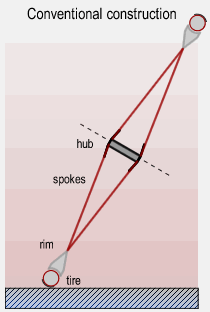 |
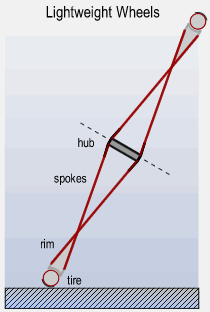 |
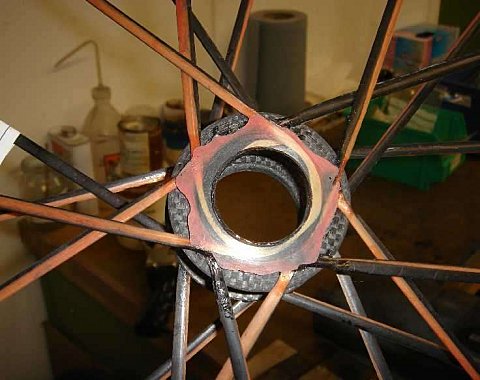 |
|
Ok nous ne sommes pas spécialisés dans le procédé donc nous laissons les experts discuter de tout ça… mais fondamentalement, c’est ainsi que les roues sont construites. Nous pouvons aussi remarquer de la mousse (foam sur la photo) autour des rayons. Nous n’avons aucune idée de leur usage ceci dit.
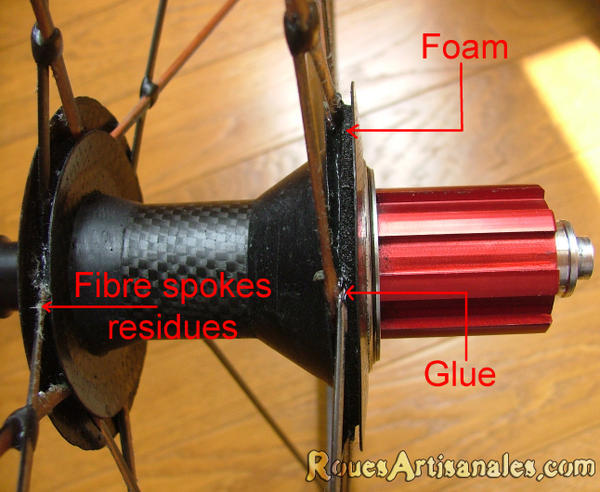 |
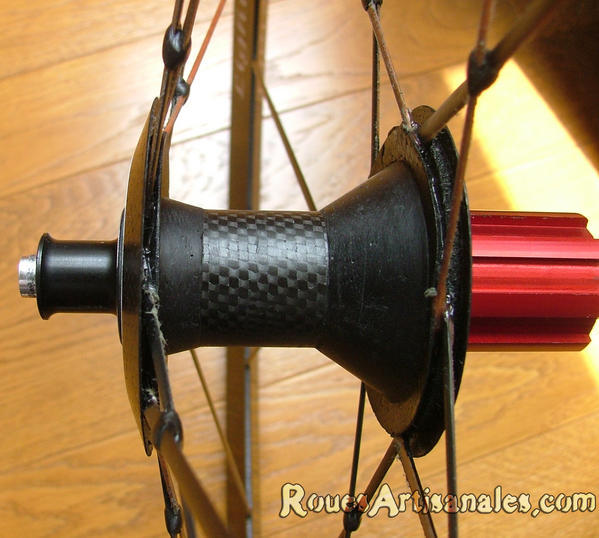 |
| Cliquez pour agrandir | Cliquez pour agrandir |
Ici encore, comme les jantes et les moyeux, la finition n’est pas parfaite. Quelques fibres de kevlar s’éfilochent et ne semblent pas « cuites ». L’aspect artisanal de ces roues est évident! Nous apprécions ce genre de petit défaut esthétique qui montre à quel point la haute technologie et l’artisanat du procédé sont liés et cohabitent!
Les rayons de la roue arrière sont ligaturés, comme ce que l’on fait sur les roues montées à la main. Cet appendice augmente la rigidité latérale de la roue et accroît fictivement le diamètre du flasque. Évidemment, les rayons de la roue avant ne sont pas ligaturés, ils se croisent dans le flasque.
Les différences entre les roues de la gamme Lightweight ont principalement rapport aux mécanismes internes et aux roulements. Les roues avant Standard et Obermayer utiisent des roulements GRW, fabriqués sur mesure pour les moyeux avant Lightweight.
La différence principale entre les deux versions que Carbon-Sports offre est donc en rapport avec le moyeu arrière. La version standard tourne sur un mécanisme de moyeu arrière DTSwiss avec son système à rochets breveté (ratchet sur la photo) . Tandis que les Obermayer utilisent le mécanisme TUNE avec le double roulement breveté aussi. Les deux mécanismes sont très fiables et durables mais le TUNE utilise un axe carbone et est bien plus léger.
| Mécanisme DTSwiss à rochers | |
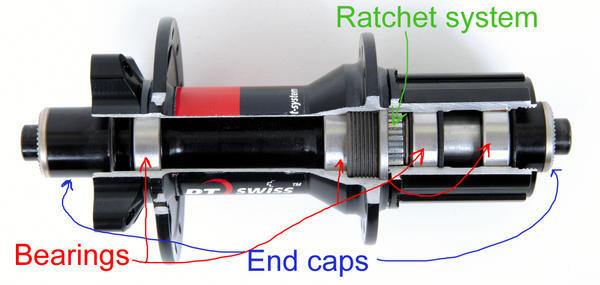 |
|
| Rochers (ratchets) | |
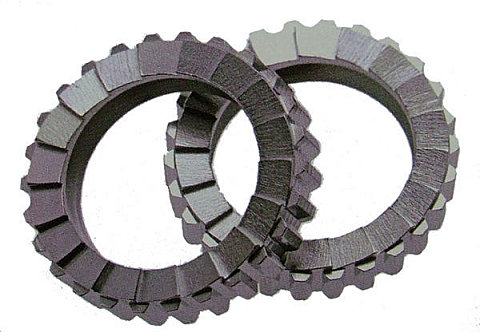
|
Concernant le voile, le saut et le centrage, les roues Lightweight ne sont pas parfaites. Elles voilent plus que n’importe quelle roue montée à la main sur laquelle le monteur s’est appliqué longtemps pour obtenir quelque chose de très rond. Ce problème est causé par le procédé de cuisson, la forme de la roue est quasiment achevée quant elle quitte le four et, elle doit ensuite être ajustée légèrement à la main. Attention cependant, ceci n’a aucun impact négatif sur le fonctionnement et le freinage car ça reste très faible. Oui, il ne faut pas trop s’inquiéter sur ce point. En revanche, à propos du centrage, c’est un peu plus inquiétant puisque ça pourrait affecter légèrement l’équilibre du vélo.
Au niveau de la douceur des roulements, la roue avant tourne sans plus jamais s’arrêter… vous pouvez la regarder tourner pendant des heures. C’est impressionnant, vraiment impressionnant! L’arrière n’est par contre pas du même niveau. Il est bien plus sérré et réclame quelques kilomètres pour être rodé. C’est commun sur les moyeux arrière TUNE à axe carbone et, bien sûr la Obermayer 2 suit la même règle.
Nous sommes impatients de rouler avec et d’avoir les résultats du laboratoire!
Oui c’est un fait, bien que j’ai pu rouler sur pas mal de bonnes roues que j’ai monté, je suis impatient de rouler avec les Obermayer 2 et j’espère m’éclater. En réalité, je ne vois pas pourquoi je ne m’amuserai pas. Rouler avec des roues de 922g est quelque chose de très spécial, seulement quelques personnes peuvent se le permettre et je suis ravi de pouvoir le faire pour quelques sorties. Un rapport complet du match avec les deux autres paires de roues high-tech sera publié dans le magasine où je bosse. Je pense pouvoir écrire sur RouesArtisanales un article similaire à celui ci à propos des deux autres paires dès que nous les recevrons.
Carbon-Sports a été la compagnie la plus rapide pour nous fournir un set de roues. C’est, à la date d’aujourd’hui, la seule qui a pu nous fournir une paire. C’est un point important et ça montre à quel point ils ont confiance en leurs produits.

As you certainly noticed, I’ve not been very active on the website lately. I’ve a workplacement in the bike french magasine « L’Acheteur Cycliste » and so the free time to work here is very limited.
Today is a day off and so I’ve the time to present what has been, since almost a decade, the lightest and stiffest wheels ever.
We had a visit in Lightweight factory during the Eurobike, I hope you enjoied this article that is still online from this link: The secret of Lightweight wheels! (available from the main page too). We think some of you could have been slightly frustrated not to see a lot of pictures of Lightweight wheels. But , we unfortunately couldn’t show every pictures because of the process secret…
That’s why, we’re happy this time to show a lot of pictures of these wheels. This set will be tested in laboratory and on the road for a great report in the magasine very soon. Stay tuned!

We think the « war » between Lew Racing, making the PRO VT1 at 880 / 920g (Shima/Campa), and Carbon-Sports, owner of Lightweight wheels, might have hurt the « ego » of the german company that feels forced to push even more the limits of its wheels! Of course this competition between the companies is very good for the final customer since the products get better and better for cheaper.
| Stefan Behrens, at the head of CarbonSports has been very reactive to get us a set for the test in the magasine. It was just a question of days, very good. We give them a big thump up! | |
| On the other side, we are still waiting for some others high-end sets from two other companies. It seems like the others companies can’t make enough wheels yet to send us a set. We really hope this situation will end soon. |
The height of the rims is 53mm for 19.5mm width. The rims skeleton is foam that brings stiffness and resistance to compression. For the generation 2, a new foam is used. It is the one used in A380 wings, it is lighter and stiffer. The carbon fiber used is the famous 3K one, it is pretty thin and is composed of 3000 carbon fibers per weave. The aesthetic aspect is really very good even through we can notice some voids at very close range.
The inner tip of the rim is flat. This is a particularity we didn’t really expect from a wheelset claimed to be aerodynamical, therefore fast. We think there is still a good improvement to bring to the rims here. A flat part isn’t really fast and it certainly explains the relative bad aero result of the front wheel to the TOUR magasine test. You can see it here, the Lightweight front wheel absorbs 24,8W and is not among the fastest wheels despite its deep rim.
A special shape hole is moulded for the valve extender, it is very well done but was slightly larger than our extender. It means we will have to block the extender to prevent the « tic-tic-tic » noise while riding. Nothing to complain about though. We thought about using some electrician tape around the extender for that. Another possibility is to cut a small piece of butyl from an old air tube to block the valve extender.
But, as a perfectionist brand, Carbon-Sports offers two tiny seals to prevent the valve extenders from entering in contact with the rim hole. This is with these small details we recognize the best brands!
A magnet is laminated inside the rim so there is no need of a big/ugly one on the spokes. Good point!
About the brake track, it is normal carbon and it requires special brake pads. Carbon-Sports advise the Swissstop Race 2000 Lightweight (see here) modified compound for them.
As the rims, the hubs are made out of 3K carbon. The look is as nice and is matched. We can notice again some voids in the carbon, this is really common for lightweight high-end bike parts and this is definitely not a problem for the suitability and reliability. But we could be waiting for more from such pricey products! No need to complain that much either, it remains a detail!
Front hub
Rear hub
The voids in the carbon
The spokes are made out of carbon and kevlar fibers. They can hold up to 1200kg of tension with no significant increase in length. Their shape is almost bladed. The dimensions differ with the process but, generally the thickness is close to 2mm and the width is close to 5mm. As comparizon, the Cx-ray stainless steel bladed spokes are 0.9mm thick and 2.3mm width.
Regarding the process, basically, the spokes, rims and hubs are laminated as one piece, forming a very solid and stiff component. The spokes are wrapped around the hub at 140/160° (depends on the spoke count) and goes to the brake track. They are glued then a carbon cap is glued as well over it to bring some stiffness and integrity. Some glue is sometimes visible around the hub/spokes. It is the red one, as you can see on an old picture of a process below.
 |
 |
 |
|
Ok we’re not specialized in the process so we leave it to the experts… but fundamentally, this is how it’s done. We can notice some foam as well around the spokes. No idea what it’s used for though.
 |
 |
| Click to enlarge. | Click to enlarge. |
Once again, as the rims and the hubs, the finish of the spokes is not perfect. Some kevlar fibers remained uncut or not well « cooked ». The crafty aspect of the wheels is definitely obvious! We do like this kind of small aesthetic issue, it shows how far the hand-made and technology sides of the process are!
The rear spokes are tied, just like what we do on handbuilt wheels. It increases the lateral stiffness of the wheel and makes a fictive bigger flange diameter. Obviously, the front spokes are not tied, they cross each other inside the hub flange.
The differences in Lightweight wheels range are mainly related to the bearings and the internal mechanisms. Both the Standard and the Obermayer front wheels versions use GRW bearings, custom made for Lightweight front hubs.
The main difference between the two version Carbon-Sports offers is related to the rear hub. The Standard version spins around a rear hub DTSwiss mechanism with its patented ratchet system. While the Obermayer uses the TUNE mechanism with its patented custom double bearing and the traditionnal three titanium engagement pawls. Both mechanisms are very reliable but the TUNE one uses a carbon axle and is way lighter.
| DTSwiss Ratchet system mechanism | |
 |
|
| Ratchets | |

|
The precision
Regarding the trueness, the roundness and the dish, Lightweight wheels aren’t perfect. They are more out of true than standard hand-made wheels that have been trued and dished for a long time. This is caused by the cooking process, the wheel shape is almost done when it leaves the oven and it has to be slightly adjusted by hand then. However, this doesn’t have any negative impact on the functionning and the braking because it is still very low. Yes, there is no need to worry about the trueness and the roundness. But about the dish, it is a bit more worrying since it could affect a little the balance of the bike.
Regarding the bearings smoothness, the front wheel spins forever… you can see it spinning for hours. It’s awesome, definitely awesome! The rear one is not of the same level. It is tighter and needs some kilometers to be broken in. This is common on some carbon axle TUNE rear hubs and of course the Obermayer 2 follows the same rule.
We are impatient to test ride them and to have the results of the laboratory!
Yes this is real, although I could ride a lot of good wheels I built, I can’t wait to ride the Obermayer 2 and I hope to enjoy the ride. Actually, I don’t see why I would not enjoy it. Riding a 922g wheelset is something very special, something only a few people can afford and I’m happy I can do it for a few rides. A full report and match with two other high-end wheelsets will be published in the magasine I work at. I do think I will report on RouesArtisanales.com a similar article to this one about both others wheelsets as soon as we get them.
Carbon-Sports was the fastest company to provide us a wheelset, this is at this date the only company able to provide wheels for the test. This is an important point and it shows how confident they are in their product.

I thought I was on holidays while waiting for our new website, well it seems I was wrong and a big new forces me to take back my pen or should I say my keyboard!
The latest Mavic wheel we spoke a lot the last months have been announced almost officially.
A small meeting to present them to the Saunier Duval riders has been organized and it ends any rumors about these – very waited and very technical – wheels.
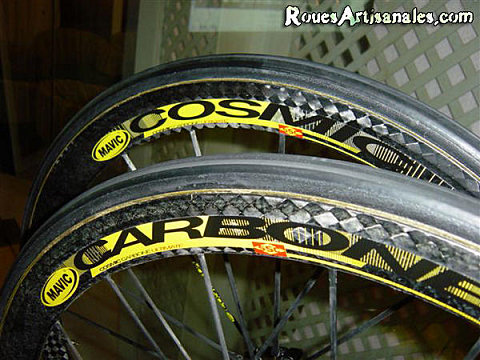
Thus, as its name indicates, the wheels are mostly made out of carbon: the rims, the spokes and the front hub. Only the rear hub is still in metal.
Here are their specifications:
| Front wheel: | Rear wheel: |
| Rim: 40mm deep Carbon fibre 12K, no drilling |
Rim: 40mm deep, assymetrical Carbon fibre 12K, no drilling |
| 20 unidirectionnal carbon spokes molded to the rim | 20 unidirectionnal carbon spokes molded to the rim |
| Hub: carbon fiber 12K, 9mm alloy axle | Hub: alloy, FTS-L rotor system, 9mm alloy axle |
| Non truable, non repairable | Truable from the non drive side spokes, non repairable |
| Tubular only | Tubular only |
| Swissstop pads included (voir ici) | |
| 1185gr the set | |
| 2300 euros | |
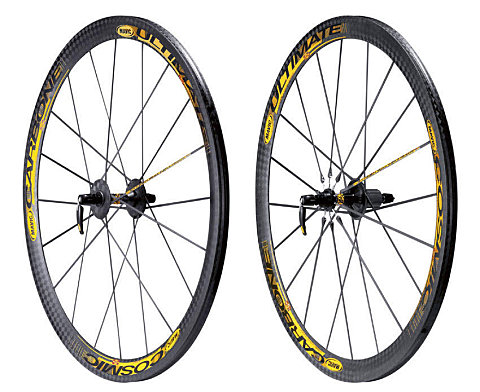 |
|
| Click to enlarge | |
We are pleased to see that Mavic could reply in a short time, about 24 months or so to a new expanding market: the high range wheels.
The wheels are not as light as the Mavic guys told us, they stood they will be as light as the direct challenger known as Lightweight (1060gr) and as stiff as them (we can not verify this yet) but this is not the case. They anyway seem promising.
The wheels are not repairable but warrantied for 2 years, we will then advise them only for great events.
Why is only the non-drive side of the rear wheel truable and not the front wheel or the drive side of the rear wheel? Simply because the front wheel is very stable, very durable whether the process to make them is controlled.
For the rear wheel, it’s a bit more difficult to have a decent opinion. We can think that the process istill has to be perfected and therefore the wheel will go out of true after a few kilometers. A lack of stiffness may forced Mavic to go to a more traditional construction to keep a stable and stiff wheel. According to Mavic press, this construction will compensate the eventual maladjustements of the wheel.
Then we think some open doors have been left opened for further improvements of the product to make the main process profitable.
Examples: full carbon rear hub, non truable rear wheel, color change, ceramic bearings, titanium axles…
About the aesthetic, it’s usual Mavic with flashy but well designed stickers and a yellow spoke. The 12K carbon fibers remind Corima rims.
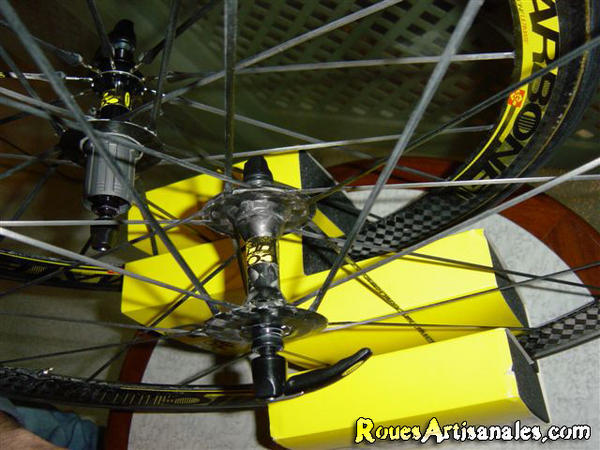 |
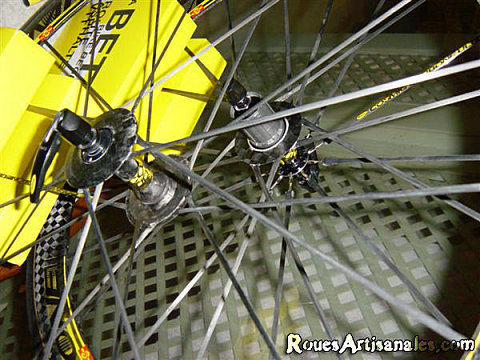 |
| Click to enlarge | Click to enlarge |
|
Click to enlarge
|
|
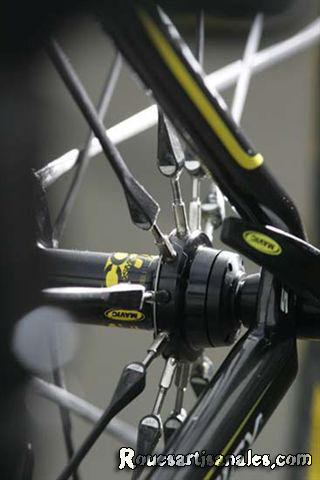 www.photomargot.com |
Click to enlarge
Click to enlarge
|
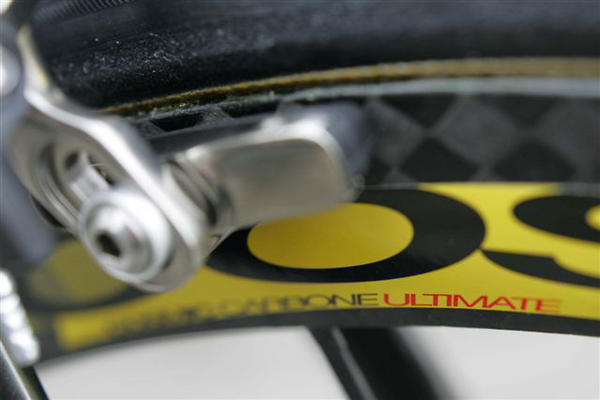

The racers amazed by the new wheels:
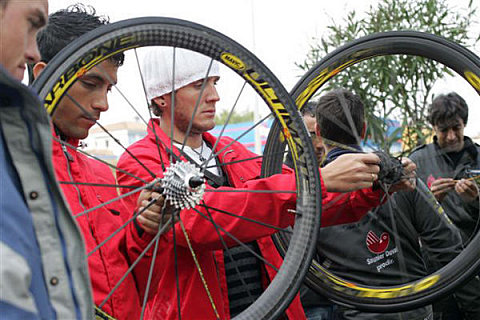
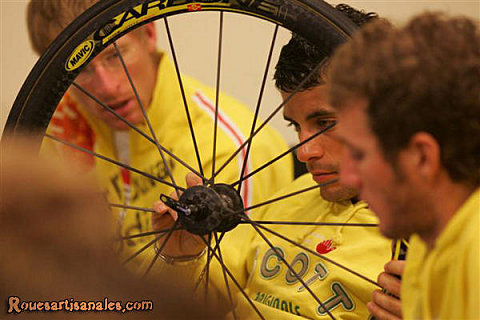
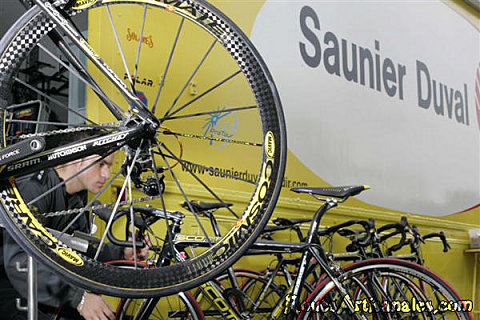
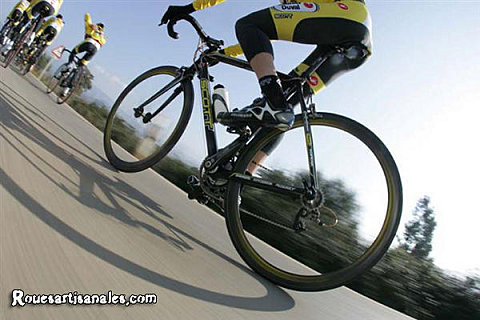
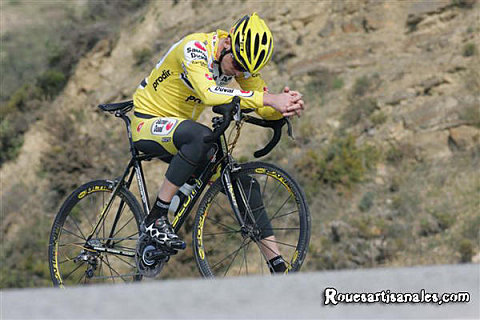
Thanks to Gonzalo for the pictures!
You can follow the evolution of these wheels on the previous RouesArtisanales articles: 1, 2, 3, 4, 5

| Front wheel | Rear wheel |
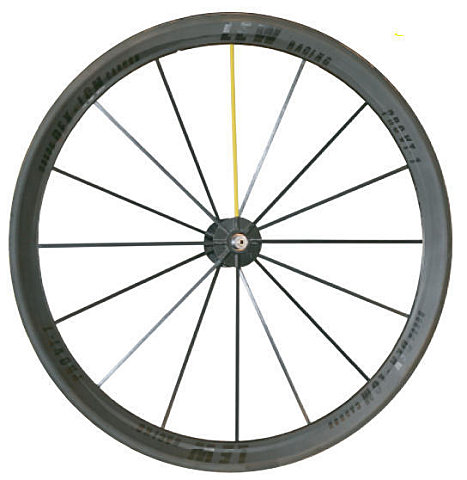 |
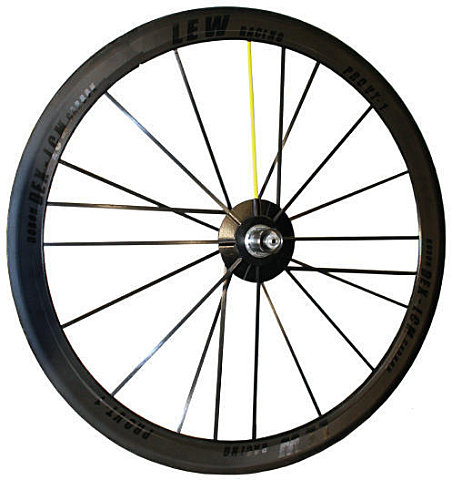 |
| Click to enlarge | Click to enlarge |
The rims are 46mm deep and 20mm wide. They hit the scale with only 230gr and their shapes have been studied to be as fast as possible. The 16 front spokes and 20 rear ones are made in the same material as the rims. They are much stronger than traditionnal stainless steel spokes according to the manufacter. The inserting process of the spokes in the rim and the hub creates no residual stress and increases the wheel lenght of life.
| Beside this advantage, the truing or tightening procedures are inexistant once the wheel has left the factory. In the case of an accident where the wheel would be damaged, the spokes can be changed separately. Just like any part of the wheel actually. It is in our opinion the biggest advantage over Lightweight wheels. The hub design is rude, very uncommon with large flanges to hold the spokes the most. Their axles are made out of carbon, 15mm of diameter. Three flanges for the rear hub… a little like FSA on its RD-600. Both external flanges hold radial spokes while only 4 spokes laced to the center flange are tangential to the hub to transfer the torque in the best conditions. This design allows a stiffness gain that – we hope – will be translated as ultimate performance on the road! |
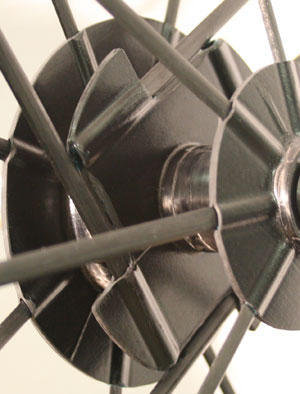 Click to enlarge
|
Only sub 84kg cyclists are allowed to ride them in safe conditions but custom builds can be made for heavier riders. They are suitable for road, triathlon and time-trial and cost US5495.
In a few months, a few brands will share the very high range wheels market (even through ADA is far from the front of the race:
| Lightweight | ADA |
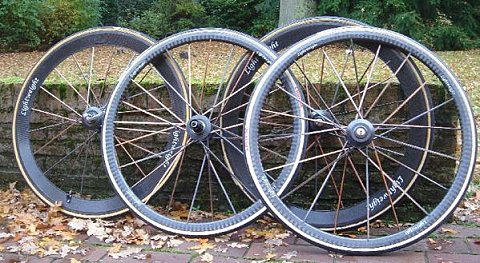 |
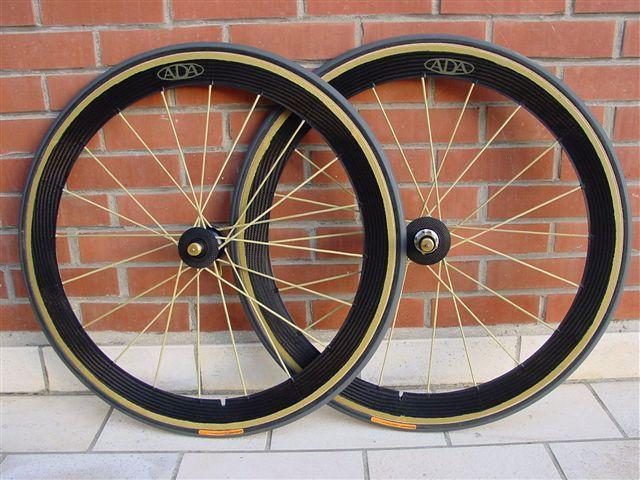 |
|
Click to enlarge
|
Click to enlarge
|
Mavic |
Lew |
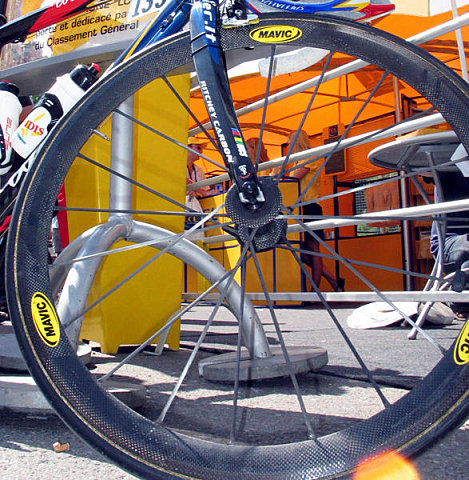 |
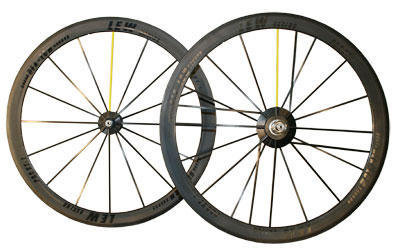 |
|
Click to enlarge
|
Click to enlarge
|